#Tanaka Box Translations
Explore tagged Tumblr posts
Text
Servamp April Fools' event
Tanaka Strike reposted the event from 2023 that was about voting for characters' abilities/techniques. The first time I didn't look into the the event and I was surprised to see that among the abilities that were listed, there were a few that were revealed later in the manga, for example Kuro's Wiedergänger (Ashes to ashes, dust to dust) that appeared in chapter 133.
In March 2023, chapter 128 was published, so it was 5 chapters later when the name of the ability was introduced in the story.
For the event, some characters have abilities that were marked as “lies” because they didn't appear in the manga however, Kuro’s ability was marked as a lie but that was actually true after all!
So yeah, Tanaka-sensei was playing with us. xD Abilities have two readings and you'll see that some of them either have one reading which is different or they some readings were assigned to other characters.

Mahiru: “Why is truth and falsehoods mixed in? Only the actual abilities should be voted!
Kuro: “Mahiru…In this world, you can’t survive on truth alone...
Kuro offering words of wisdom xD The abilities that were marked as "lies" have conversations or comments from characters which I translated.
Note: I listed the abilities based on the characters' names in alphabetical order.
GEAR
Mister Violence (Antique clock of night trick)
This is a reference to “Gear of Night Trick” on TanakaBox and that’s why I worded the translation like this. The clock referenced here must be Hlidskjalf. I wrote about it here when I posted chapter 96.

Youtarou: It's not an ability, it's just brute strength, isn't it?
Gear: I'm a wolf so I have no choice. It's a world that's tough to live in for someone like me.
Youtarou: Honestly! You always act like a wolf at times like this!
HYDE
Cute aggression (The Taming Of The Shrew).
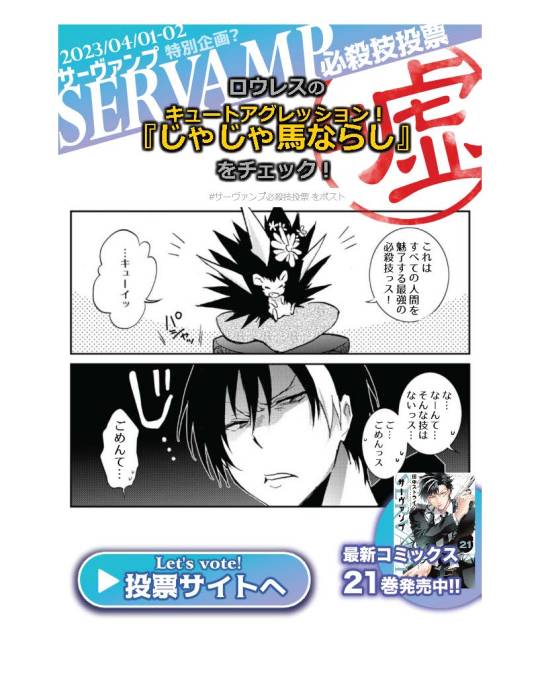
Hyde: This is the most powerful ultimate technique that charms everyone! Kyui!
J-just joking...I don't have a technique like that... I'm s-sorry...I said I'm sorry...
JEJE
Mary Magdalene (Jesu, Joy of Man's Desiring)
In chapter 125 when Jeje was given his name by Mikuni, his contract item was the winding key from the music box that Kiriko gave to Mikuni and I read that fans discovered that the song it was playing was "Jesu, Joy of Man's Desiring"
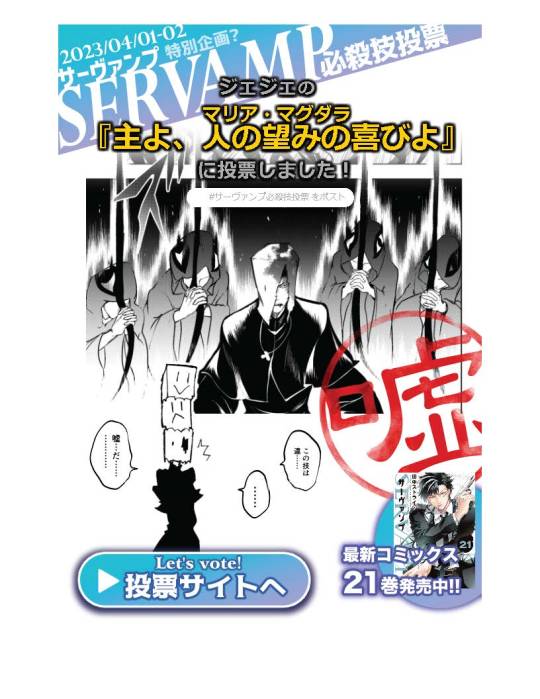
Jeje: This technique isn't... It's a lie...
KURO
Wiedergänger (Ashes to ashes, dust to dust)

Mahiru: Hey! If you're gonna lie, you should make it sound like it's… obviously a joke, or it'll just confuse people.
Kuro: Yeah...I don't really have a cool technique name. I'm just a humble cat...
LILY
Turandot (None shall sleep) Like I mentioned in the beginning, this is one ability that was given a different reading. The actual one is "The king is absent today as well." "None shall sleep " (Nessun dorma) is an aria from the final act of Turandot.

Mahiru: You had a technique like that?
Lily: Fufufu...Well… you could say it exists, or you could say it doesn't. Reality is such an uncertain thing. You should also be careful.
MISONO
Bridge falling down (The king is absent today as well)
So yeah, it's Misono and Lily that had their ability names switched and were also given different readings. The different reading is most likely a reference to the nursery rhyme "London Bridge Is Falling Down". And we don't have Misono, we have Mikado who comments about the ability xD
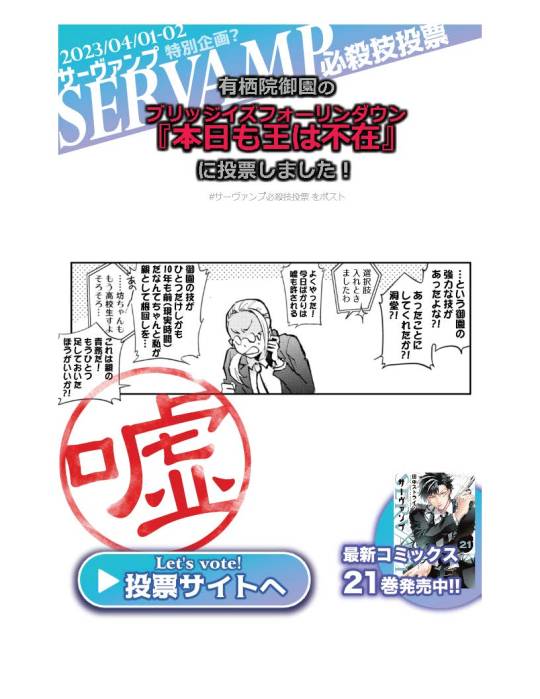
Mikado: Didn't Misono have a powerful technique like that?! Did you make it sound like it existed, Dodo?! Dodo: I included it as an option. Mikado: Nice work! Just for today, even a lie is permitted. I can’t believe Misono had only one technique, and it was from ten years ago (in real time)…As a parent I must do behind-the-scenes... Dodo: Young master is already in high-school...It's about time you... Mikado: This is a parent's duty! Should I add another one?!
SAKUYA
I will die yesterday by your side (Five-minute hypothesis theory)
Sakuya used this ability in chapter 139, however in the manga it says five "seconds" not minutes. The first reading sounds weird...Like, I haven't found a reference for it. "To die" is in the present tense even though it says "yesterday", so yeah, it's weird. I expected that it would be the name of a novel but I haven't found anything, so if some of you might have an idea about it, let me know!

Sakuya: I used this ability in the fight against Mahiru, didn’t I? It was such an emotional technique where I self-destructed to protect him. Tsubaki: Have you actually been reading Servamp??
TOUMA
The Beast of Gévaudan (The beast that crawls in a windowless room) (note, for the first part it's actually in French, La bête du Gévaudan)
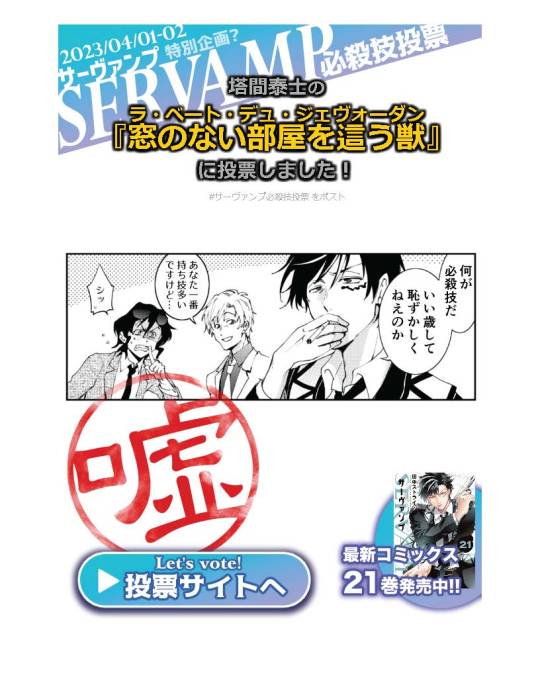
Touma: What’s the deal with finishing moves? Aren’t you too old for this?
Iori: You're the one that has the most of them though....
Tooru: Shh!
TSUBAKI
Mahoroba (Under the moonlit night, rain and carnage)
Mahoroba isn't something that can be translated. It's a term that refers to an idyllic or perfect place, often associated with paradise or a beautiful land. The dictionary defines it as "great and splendid land (of Yamato)"
The other name of the ability is the title of chapter 84, which I initially translated as "On a moonlit night, rain and bloodshed"

Tsubaki: I don't recall mentioning such a technique name, but it seems okay as it is.
Ultimate Super Wars (Super Ultimate Form-Tsubaki-)
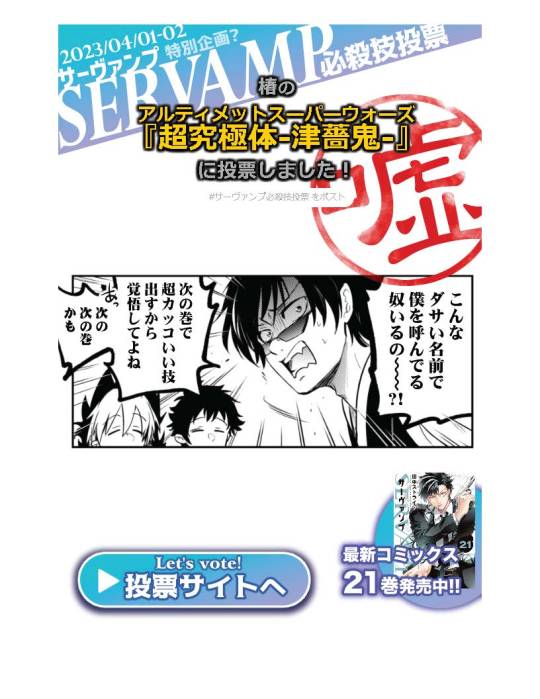
Tsubaki had another ability and when I googled アルティメットスーパーウォーズ a novel, I assume, showed up but I couldn't find much about it. Based on the cover of the book, I thought it was adapted based on a videogame but I didn't find a game with that title, so yeah, the name of the ability might not be related to it. Regarding these kanji 津薔鬼, they spell Tsubaki.
Tsubaki: Are there people who actually call me by such uncool name?
Get ready for an awesome technique in the next issue! Or perhaps the one after that.
YUMIKAGE
Valkyrie Brunhilde (Swan Lake)

Yumikage: This is actually my brother's...But I have many cool name ideas for my own abilities.
#servamp#april fool's event#kuro#tsubaki#gear#misono alicein#lily#sakuya#jeje#hyde#touma taishi#yumikage tsukimitsu
94 notes
·
View notes
Note
do you have any rpg maker horror recs? :> (or horror games in general)
cell of empireo (no official eng translation but there's a fantranslation on youtube)
you play as haruki atou, an investigator, looking for his amnesiac coworker who had gone missing near the empyrean heaven research institute (n theres so many other things going on). involves chases, quicktime events n realtime bosses
warnings: flashing lights, religious themes, cults, death, child + animal death, human + animal experimentation, gore, body horror, cannibalism, bullying, abuse and parental neglect, suicide/suicidal ideation, murder
what i like about it: the story, the themes, the characters + their relationships, the horror, secrets/lore
2. jimmy and the pulsating mass
you explore the dreams of a boy named jimmy while trying to fight off "aliens". it's a very charming game ^_^ a good chunk of it is silly instead of scary. involves turn-based battles
warnings: gore, death, child death, murder, body horror, bugs
what i like about it: the music, the world, the story, punch tanaka



3. cat in the box
youtuber girl goes into an abandoned building n regrets it. but there's a twist! also there's a lot of randomized secrets too which is cool. involves chases
warnings: death, murder, body horror, distorted faces (possibly more)
what i like about it: the horror, the secrets


4. LISA the painful (tied to LISA the first and LISA the joyful)
you play as brad, a man who has gone through a lot, in a post-apocalypse where all women have disappeared except for 1 girl - your adopted daughter. she's been taken away from home n you have to find her. the definitive edition adds some new scenes + fights. involves turn-based battles
warnings: sa and csa (not explicitly shown visually but the affects of it play a major part on all protags in the series), parental/familial abuse, drug addiction, alcoholism, bullying, self harm, suicide, misogyny, gore, death, child + animal death, murder, body horror, references to sex in general, vomit, race joke that may or may not still be in there
what i like about it: the music, the horror, the world, the secrets, the themes, the gameplay, terry hintz


bonus: paranormasight (visual novel) i'm drawing a blank on how to summarize it n what all the warnings are rn... familial abuse n murder are some. it's bloody n touches on dark things but its not as heavy tonally as some of the other games on this list. the character interactions r really fun



#i talk abt never recing lisa to anyone but i gotta put it in here... fundamental ghooost game#5. my ga-#asks#body horror
39 notes
·
View notes
Text
Ch202 (p3), We are all footmen
I'd still worry.... 😅
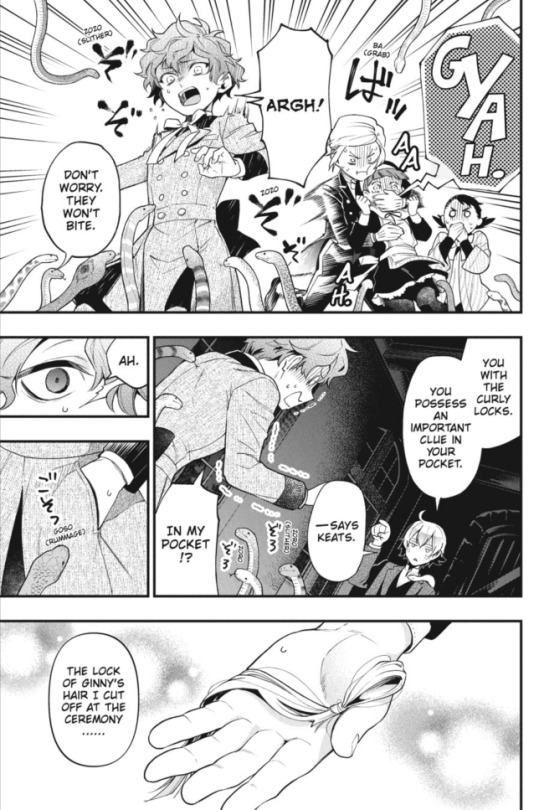
So, Theo apparently kept that lock of hair in his coat pocket. I guess he forgot to remove it earlier and put it somewhere else, like in a keepsake box. Is this the "key" that -- was it Editor K? -- spoke of before, that Theo has to the mystery?
The snakes can sniff out Ginny, based on the scent of her hair, and they can tell if she's alive (warmth) or already dead (ambient temperature). If she's alive, even the slightest temperature changes would help them find her.
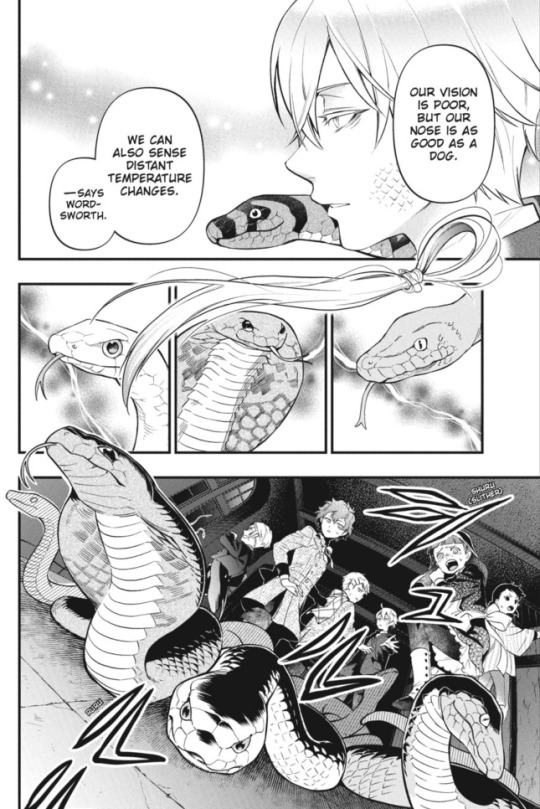
Well... Artie actually has a valid question! We don't really know what Snake is.

It's funny thinking back to when Tanaka tells real Ciel that Phantomhive Manor would typically employ numerous footmen. Snake has been referred to as the footman. But the truth is they all see themselves as footmen... even though only one has feet. 😆
There's a jingling noise, probably from a horse, and everyone turns their attention in that direction. Jonathan is a new snake to me, though he's probably been around the whole time... and he just keeps quiet.
The students go follow Jonathan, while Snake and Finny trail behind.
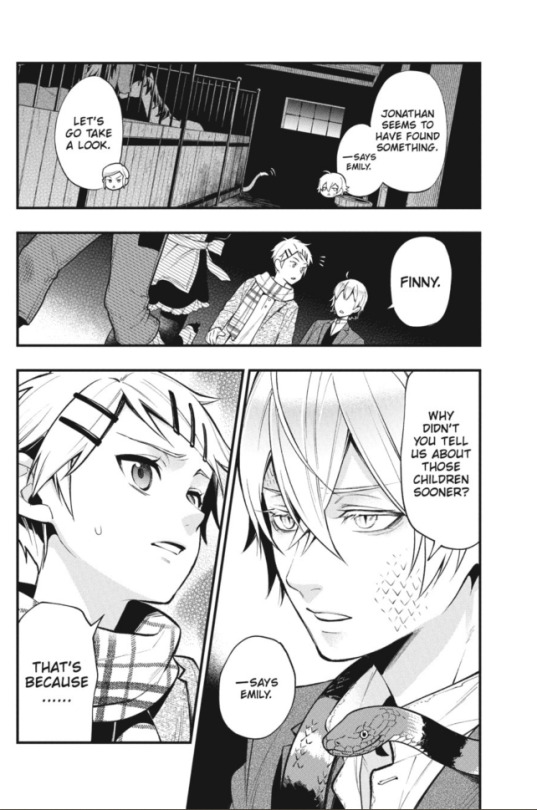
Finny doesn't know how to explain why he's kept quiet. Mainly it's because he had to be sure before accusing Doll of being an enemy.
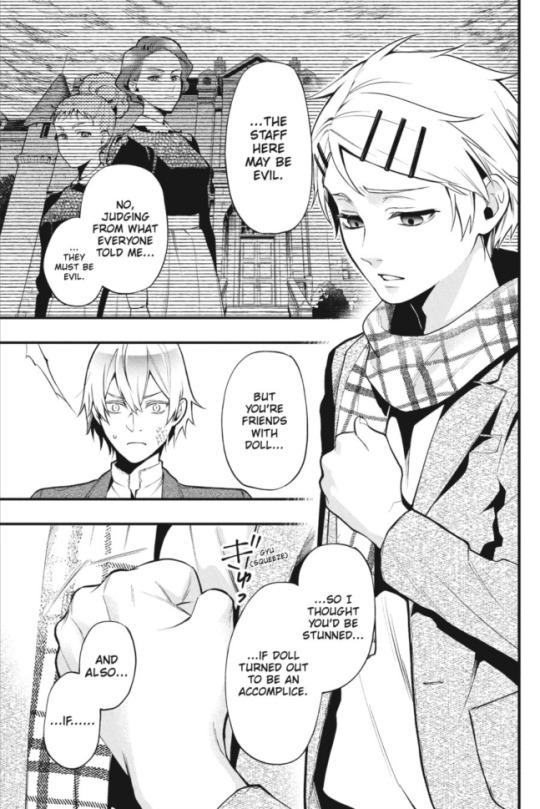
But he's also afraid Snake will find out that Finny helped to kill Snake's friends from the circus.
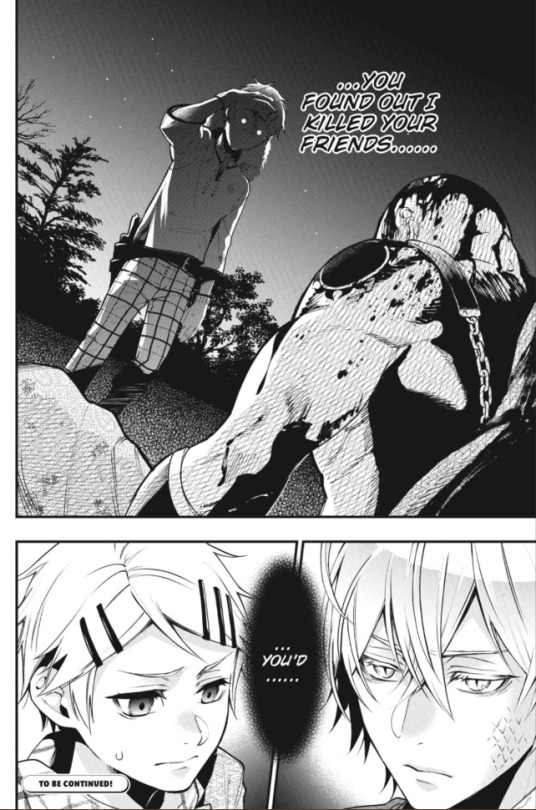
Is he more worried that Snake would turn against him and our earl (and the others) or simply that he'd feel betrayed and end the friendship they've built?
Well, the licensed translations never come with the preview for the next chapter, but in this post, we get a heads up that ch203 should actually start a flashback for Finny.
#black butler#kuroshitsuji#ch202#chapter release#chapter review#chapter analysis#finny#finnian#snake#snake's snakes#fol orphanage#orphanage#ginny#top students#doll#circus members#circus troupe#part three#part 3#jul 18 2023
80 notes
·
View notes
Text
blood on vacation

David Barrón/F!Reader
written for @narcosfandomdiscord's smut alphabet, namely the July 2 prompt blood
tags: fistfight, absolutely unhinged preoccupation with bloody knuckles, fingering, oral sex
warnings: blood, probably unsanitary, reader is an OFC (Sabrina Tanaka), violence, this was not beta read and it kind of sucks ngl
length: 1.8k words
You’ve only been Mexico City for a week, and you’re already all vacationed out. It’s not Marcela’s fault. The two of you make no sense as friends—she, the trust fund kid formerly known as Marcelo who initially met you at your dad’s jiu jitsu academy, currently partying her way across the globe with an increasingly dodgy set of cousins, exes, and assorted other rich vagabonds, and then you, the standoffish sparring tutor forever known as Mr. Tanaka’s kid, with an unhealthy penchant for taking your skills to street wanderings, just to see if you could. She was whimsical and merry, spiritually curious and given to bouts of dangerously committed romantic pining, and you were stolid and practical and highly suspicious of anyone as eager to please as a car salesman, much less a preacher or supposed future lover. The one similarity between the two of you is that you both were born and raised in São Paulo, and could both kick hard enough to break bones. But the rest? Pure opposites attract chemistry.
She’s been generous on this trip, doing the rich girl thing in splendid style, and footing the bill for your part completely. She translates for you whenever she sees you getting lost—Brazilian Portuguese is similar enough to Mexican Spanish that you can kinda sorta understand what people are saying if they’re saying it slowly and doing overtime with the nonverbal cues—and does it naturally, not like it’s a chore or an opportunity to show off. She introduces you to her club kid friends with excitement, like she’s showing them someone really cool. She’s a sweetheart, Marcela is, and you’re more than happy to wingwoman her into a spot sitting on the lap of some baby narco named Ramón. But the good food aside, you’re still so alienated and bored that when a fistfight breaks out in the club, it come as a welcome change of pace.
There’s broken glass on the ground—Ramón’s older sister smashed a bottle over somebody’s head, good for her—so no ground fighting for you. And there’s too many people around to dedicate yourself to a hold. So you fall back on a motley bag of street fighting tricks, plus what you learned from a misspent summer at a boxing club, mostly just trying to stay upright and get your licks in where you can. It’s all fun and games until one of them slaps you, open palm. A punch would’ve been fine, but this? You hit his nose with the base of your palm, driving up to break it, then follow that up with a jab. Not satisfied yet, you sweep one of his feet out from under him, shove hard, and finally get him on the ground (broken glass be damned) in a hold that has him gasping fruitlessly for oxygen, his neck in the crook of your arm, his body trying to wriggle round and find an angle at which his elbow shots to your ribs will actually mean something. Unfortunately for him, when you’re pissed off, you could take it all the way to fully broken ribs and not care. Fortunately for him, nobody there actually wants anyone to die, so after a bit, several people pull you off him. One of them is Marcela, so you give it up. The fight has died down anyways; both sides are separating into bloodstained, wary-eyed groups.
Keeping steady eye contact with the man who slapped you, you lift your bloody-knuckled hand to your mouth, part your lips, and lick a long stripe of his blood off your skin. Slow and intentional and savagely self-satisfied.
As you turn to talk to Marcela, ask her where the bathrooms are so you can clean yourself up a little (Ramón is already yelling about partying the whole night through, and Marcela seems completely unruffled, so you doubt you’re all about to leave now), you catch a glimpse of something. Everyone here is preoccupied with their injuries, or other people’s, or the retreating crowd of interlopers, except for one man who seems to have witnessed your last threat. He’s dressed a little different than the others, in an oversized polo shirt. You remember getting a glimpse of him in the fight, thinking you might need to take him on next and grimly assessing that prospect as a dangerous one before he easily elbowed a guy who was heading for Ramón’s brother. So he’s not useless, and he’s not easily cowed. Just now, he’s looking back at your challenge of a glance with a flat-eyed expression that you can’t quite parse.
Hm.
No language in common and barely any friends, but you wanted a kill and you didn’t get one, and here’s another man. You’ll have to make do with another kind of death.
.
.
.
Inside the club bathroom, he hooks his fingers over the top of your jeans and tugs you forwards a couple inches. Commanding, but not a threat. Not trying to make you stumble, just getting you that much closer.
Regarding him with a curious, almost lazy look, you’re almost inclined to let him have his way, but then, as he goes to unbutton your jeans, his knuckles smear blood along your stomach. You close your hands over his wrists, and he pauses.
“Go wash your hands,” you say, slow and clear, lave as mãos. And he gets it.
You know he gets it, because he looks down at your hands, your bruised, swollen, bloody hands, and then back up at you in a way that makes his blank expression rather pointed. Oh, does the international man of mystery have a sense of humor after all?
“Do it,” you say, faça isso. That must not be close enough to Spanish, because he frowns a little. You give up.
You pull his hands out of your jeans, feeling a shiver go through you at the friction, and then you let go of him, walk over to the sink, and turn on the tap. As you lean back against it, the countertop digs into your thighs, suggestive. The dull pulsing thump of the club music outside gives the tiny bathroom a cloistered, cocooned quality. His dark eyes meet yours evenly.
You don’t move, don’t so much as lift an eyebrow. Silent. Yeah?
Yeah. He takes a couple steps forward and washes his hands, and as he does so he mutters something to himself in yet another language, English, maybe. As he dries his hands, he smiles. It’s a wry, private smile.
Two can play at that game. In your mediocre, third-generation Japanese, you say, “I have every intention of eating you whole” in exactly the same voice another woman might’ve said something sexy.
As he steps towards you, you could swear he says something that sounds like gostaria, dangerously close to I would like that, almost like he understands you.
You decide: no more talking.
Zero to a hundred. He tastes like beer and you, unfortunately, can’t get enough; your hands cup the back of his head, his neck, fingertips digging in as he finally unbuttons your jeans and shoves them and your panties down your thighs in one impatient motion. You could hop up onto the countertop, but why do that? This way is so much better, his wet hands gripping your ass, the swift coolness of droplets sliding down the back of your thighs, the low grunt he makes when he lifts you.
“Sorry, was that hard for you?” you say, but he’s two steps ahead of you. Got his palms warm on the inside of your knees, spreading your thighs and catching sight of just how wet you are for him. It’s his turn to be smug, clearly, but you can’t even be mad at it when he wears that smile so well.
He gets on his knees.
You should’ve known it’d be like this from the second you caught his eye in the aftermath of the fight. You really should’ve known, but it still punches an unwanted sound out of you, a small sound in the back of your throat, when he gets his face between your thighs in seconds, no hesitation, and starts to lick your cunt like it’s ice cream and he’s starving.
With the countertop digging into your legs and the mirror hard against the back of your head, your body throbbing with new bruises, you have no right to feel this good, but you do. With your fingers sunk into his hair and your eyes half-lidded, you feel like you could melt and slip right down that drain. For his part, he’s got you just how he wants you, with your legs parted wide to accommodate the width of his shoulders, his right forearm a bar across your belly. You have no fucking idea how or why he’s doing this—men who see you gone full destroyer don’t usually think to themselves, I want to make her feel good, they tend to think along much darker lines. They want to dominate you, and you get what fun you can out of the process of denying them that. But this? He got on his knees like it was his first choice. You do not know what this is, but you’ll take it. He slips a finger inside you, and you’re so wet that it barely burns at all. Two fingers. Fuck. He leans his weight into your stomach, across your thighs, to stop you from bucking up into his mouth, and that’s—that’s fair. It’s all you can do not to whimper, and your heavy panting sounds desperate enough. Three fingers and you do whimper.
He looks up, and you’re already bracing yourself, but no. There’s no sneer in it; there’s something else. All night, this nameless man has been quiet, unnoticeable, and then, once noticed, mysterious, but now you see him. The first look is caution, but the second? The second is all appreciation, like he could drink the sight.
That look hits you hard. You close your eyes, because you don’t want to see it, don’t know what the hell to do with it, and choose instead to sink deep into the sensations in your body as he wrings you out. A wave of euphoria hits you as you come, and it’s just the body, you know it’s just the body, but when it’s over and he has his chin propped up on your thigh, both of you looking exhausted, neither of you done, you get the weirdest urge to push his sweat-damp hair off his forehead. Little killer, you want to say. Damn near affectionate. (It’s just the body.)
.
.
.
The cops arrive at the club before you can manage to return the favor, and Marcela hates all interactions with the cops with a flaming passion, so you have to get her out even though in all likelihood Ramón will just have to flash them a medium-size wad of bills. Later, though, when you can, you confess all (most) of the strange encounter to her, and she gets the message out to him. Through which of the tiny terrors, you don’t want to know. Probably Ramón, a thought that does not fill you with confidence. But he gets the message anyway.
The message is: I owe you one.
#David Barrón x reader#Narcos mexico#narcos mexico imagine#narcos mexico readerfic#David Barrón#mine#nffalphabet#well. that happened.#was it good? no but we gotta make progress somehow. gotta start somewhere. etc
58 notes
·
View notes
Text

COSTUME GACHA ST@RT!
The special Costume Gacha has returned! This box will features all the past limited outfits as well as a handful of limited cards in the pool
※ you are only able to do PAID pulls with this special box ※ the contents of the box feature all PERMANENT cards adding on LIMITED cards released until 2024/03/29 15:00 JST
Every 10-pull will also give you one Outfit Pick Ticket, that will allow you to choose one of the outfits available. If you have obtained every outfit available, the ticket given will be a LTD-including SR Minimum Ticket
The costumes available for this gacha are:
[2023] Delight Summer
[2024] Frisky Summer ※ flavor text translations located under the readmore
The box will run until August 19th 11:59 JST
2024 SWIMSUIT COSTUME FLAVOR TEXT TRANSLATIONS
illumination STARS
[Frisky Summer] Mano Sakuragi Vacation! Swept away by the Sun Orange
[Frisky Summer] Hiori Kazano Vacation! Cool and dry
[Frisky Summer] Meguru Hachimiya Vacation! Sentimental and hygienic...
L’Antica
[Frisky Summer] Kogane Tsukioka Vacation! Feels like a Blue Hawaii
[Frisky Summer] Mamimi Tanaka Vacation! Dancing In the Sea at Night
[Frisky Summer] Sakuya Shirase Vaction! I want to swim the night sky with you
[Frisky Summer] Yuika Mitsumine Vacation! It's either an adventure or a maze!
[Frisky Summer] Kiriko Yukoku Vacation! This small serenade, deeper than the indigo blue
HO-KA-GO CLIMAX GIRLS
[Frisky Summer] Kaho Komiya Vacation! Preparations for all out fun is a-go!
[Frisky Summer] Chiyoko Sonoda Vacation! Don't get a mesh-patterned sunburn
[Frisky Summer] Juri Saijo Vacation! Whimsical sunny day
[Frisky Summer] Rinze Morino Vacation! Rinze will watch you like a hawk
[Frisky Summer] Natsuha Arisugawa Vacation! Matching my street clothes so its a must buy
ALSTROEMERIA
[Frisky Summer] Amana Osaki Vacation! How many ♡ are there in total?
[Frisky Summer] Tenka Osaki Vacation! You Are ♡ Devi
[Frisky Summer] Chiyuki Kuwayama Vacation! I'll shoot out my ♡
Straylight
[Frisky Summer] Asahi Serizawa Vacation! Here it comes! A hot summer!
[Frisky Summer] Fuyuko Mayuzumi Vacation! Indestructible
[Frisky Summer] Mei Izumi Vacation! Time to be active and flapping
noctchill
[Frisky Summer] Toru Asakura Vacation! Material for the literary illiterates
[Frisky Summer] Madoka Higuchi Vacation! It's just water
[Frisky Summer] Koito Fukumaru Vacation! Subtropical blue
[Frisky Summer] Hinana Ichikawa Vacation! Exciting Coral Purple
SHHis
[Frisky Summer] Nichika Nanakusa Vacation! Time to get out the evening rouge
[Frisky Summer] Mikoto Aketa Vacation! Sandcastle
CoMETIK
[Frisky Summer] Luca Ikaruga Vacation! Two faces Othello-chan
[Frisky Summer] Hana Suzuki Vacation! White, Black, and Summer
[Frisky Summer] Haruki Ikuta Vacation! Tanning in the summer shade
2 notes
·
View notes
Text
First thing I've done in 2023:
Write a WorShuu fic and finally make a Tanaka Box account after like 3 fucking years of not knowing how to play (I just used google translate... I.. I was desperate..)
#servamp#2023#worshuu#ildio x shuuhei#servamp ildio#servamp shuuhei#i.. I am really the only person keeping this stupid ship alive#why am i like this#literally the first fucking thing I did was write a stupid WorShuu fic what the fuck#Literally WorShuus number 1 fan#Wtf
7 notes
·
View notes
Text
Nampō Roku, Book 7 (66): Fusube-chanoyu [フスベ茶湯] -- a Tea Gathering Held Out-of-doors.

66) With respect to the expression fusube-chanoyu [smoky-chanoyu], this is a slang term¹. This [name] refers to [the practice of] no-gake [which means hanging up a kama in the field]². Purity of mind, as well as in a physical sense, is its guiding principal³.
At Daizenji-yama [south of Fukuoka], and also in the pine-barrens at Hakozaki in Chikuzen [now within the confines of Fukuoka City], [Ri]kyū improvised -- since [these chakai] were [being staged] in the shade of the pines -- by raking up pine-needles [as fuel for the fire], which seemed [to him] a very natural way to boil [the kama]⁴. When the boiling [water] raised its voice in the pine-wind[-sound], the smoke, rising upward like a column, was very interesting⁵! Since after that his highness, when indulging himself with an outing [for such purposes as hawking], often called for [Ri]kyū, [Sumiyoshi-ya] Sōmu [宗無], or else [Tennōji-ya] Sōkyū [宗及], [to perform] this “fusube-chanoyu,” everybody started referring to it as smoky-chanoyu⁶.
At Daizenji-yama, a one-chō [square] on the south side of the lower [post] road [was secured for Rikyū’s fusube-chanoyu]; while at Hakozaki, in a direction north-east of the Ebisu-dō [惠比須堂], four or five chō were cordoned off as the tea area. The unryū-gama was hung from a pine tree, and a tea-box was opened [to reveal the utensils]. [These details] are also [described] in [Ri]kyū's oboe-gaki [覺書]⁷.
On [another] occasion at the Tadasu[-no-mori], on the middle path leading to the [Lower Kamo] Shrine, [Rikyū hosted a fusube-chanoyu] beside the stream that flows through that small grove of pines⁸. Up until that time, when there were no pine trees, the kama was suspended from three lengths of bamboo [bound together at the top to form a tripod]. And when water was [flowing] nearby, so that the mizusashi could be dispensed with, the chakin would then be placed on the lid of the kama [throughout the temae]. When a certain person asked about the thinking behind this one gathering, with respect to doing that kind of thing, [he wondered whether] things should have been done that way? 〚[To which came this reply:] “in this particular gathering, with respect to the matter of purifying [the utensils] through rinsing [them], it was not only the things that were used to prepare tea [that were so purified]⁹.”〛
When doing something with one’s whole heart, no action is ever trivial. And as soon as we achieve mastery, we should immediately look back to assess our own capabilities [honestly] -- this is what has been handed down¹⁰. 〚The hearts of the people should not be sullied; and to be ignorant of this is a grave disgrace¹¹. Even if it were placed on the ground, we might expect it not to be dirtied -- if the heart has been purified. The mind of a single nen [念] is difficult to comprehend, so it is said. But if [we] say that it is difficult for us to understand this one gathering, [we must not forget that] it is extraordinary when even a group of great monks are all moved to admiration by the same thing -- and so the other people had best keep [their opinions] to themselves¹²!〛
The understanding of this monk -- as well as [that of] many other [people] -- is exceedingly shallow. So it cannot help [me to comprehend this matter]¹³.
_________________________
◎ This text appears to be an Edo period effort to expand Rikyū’s comments on the way to host an outdoor tea gathering in Book One* to encompass the sort of “philosophical tea” that was being promoted by the Sen family during the first century of the Edo period (in the wake of Takuan Sōhō’s influence).
The different versions of this entry are more or less the same†, though there are some differences -- the most important of these is that Shibayama Fugen’s toku-shu shahon [特殊写本] and Tanaka Senshō’s “genpon” [原本] texts add some important information near the end of the passage. I have attempted to incorporate these ideas into the translation, enclosed in doubled brackets, as always.
And finally, in addition to the text and its variants, I decided to translate Tanaka’s comments (on the last section of the entry, the section that deviates from the Enkaku-ji version) in full, in an appendix (that will be found at the end of this post) -- because I believe the modern practitioner of chanoyu will find his insights both amusing and enlightening. ___________ *See the posts entitled Nampō Roku, Book 1 (31): No-gake [野懸け]¹ -- the Daizen-ji Mountain Chakai, and Nampō Roku, Book 1 (32): No-gake (part 2) -- the One Path of Tea. The URLs for those posts are:
○ Nampō Roku, Book 1 (31): No-gake [野懸け]¹ -- the Daizen-ji Mountain Chakai:
https://chanoyu-to-wa.tumblr.com/post/176889262939/namp%C5%8D-roku-book-1-31-no-gake-%E9%87%8E%E6%87%B8%E3%81%91%C2%B9-part-1
○ Nampō Roku, Book 1 (32): No-gake (part 2) -- the One Path of Tea:
https://chanoyu-to-wa.tumblr.com/post/177035199937/namp%C5%8D-roku-book-1-32-no-gake-part-2-cha
†So much so, apparently, that Tanaka only bothered quoting the very end of the passage, where the additional information is found (cf., footnotes 9, 11, and 12, below). As a result, I will not be able to discuss any earlier variants in his genpon text -- as I will be able to do, in the footnotes, with Shibayama’s toku-shu shahon material.
¹Fusube-chanoyu to iu-koto ha zoku-myō nari [フスベ茶湯ト云コトハ俗名也].
Fusuberu [燻べる] means to fill a space with smoke, so fusube-chanoyu [燻べ茶の湯] means smoky-chanoyu, chanoyu being performed in a smoke-filled space (the smoke tends to buffer or isolate the gathering from the surrounding expanse of nature, much as the walls of a tearoom do, creating a unique sensory experience).
The charcoal used for chanoyu is carefully selected precisely so that it does not produce any smoke as it burns. Here, creating a fire using the slightly damp pine needles that are found naturally in the spot, produces quite the opposite effect -- creating a misty sort of situation that is enhanced by the pine trees (which seem to hold in the smoke, keeping it from rising or dissipating quickly). Furthermore, the smoke is perfumed with the smell of pine resin, making it less offensive than would be the smoke from imperfectly carbonized charcoal.
Zoku-myō [俗名] means a popular name -- the word seems to include the nuance that said term is a little slangy or lowbrow.
Here Shibayama Fugen’s toku-shu shahon has: fusube-chanoyu to iu-koto ha, zoku ni iu na nari [フスベ茶湯ト云コトハ、俗ニ云フ名ナリ]. This means “when we speak about ‘fusube-chanoyu,’ it can be said that this is a rather vulgar epithet.”
²No-gake no koto nari [野ガケノコト也].
No-gake [野懸け, 野掛け] means to hang (the kama) up in the field.
In other words, this is the more polite or cultured designation for the practice.
In chanoyu it was not uncommon for the crude usages of servants and laborers to be incorporated into the lexicons of the different schools during the Edo period* -- perhaps this was a reflection of the general tendency toward secrecy and dissimulation that began to pervade the practice after its division into a number of competing schools (each of which was intent on keeping their ways of doing things secret from the competition). ___________ *Two well-known examples are the terms tsukubai [蹲踞] and nijiri-agari [躙り口].
Tsukubai was appropriated from son-kyo [蹲踞] (the same kanji, albeit read with a different pronunciation), the formal crouch assumed by the participants in a sumo match -- apparently the gardeners likened the attitude assumed by the guests when rinsing their hands and mouths at the low chōzu-bachi [手水鉢] to the son-kyo, but used this alternate pronunciation (which actually derives from the first kanji) as a way to disguise their jibe.
Likewise, nijiru [躙る], which means to shuffle, was a way to jokingly describe the awkward way that the guests have to wriggle in slowly, moving their knees forward little by little, through the nijiri-guchi. The nijiri-guchi itself appears to have been preferred by the machi-shū followers of Imai Sōkyū, and become standard (even in the larger rooms) under Sōtan. (Rikyū’s rooms with nijiri-guchi were all rebuilt in this style during the Edo period -- despite the propaganda, spread by the Sen family, which argued that they were authentic. The sliding doors in the seawall that were Rikyū’s inspiration were stepped through, as in Rikyū’s naka-kuguri [中潜り] located between the inner and outer roji, not passed through on one’s knees.)
Let us entertain a brief digression here.
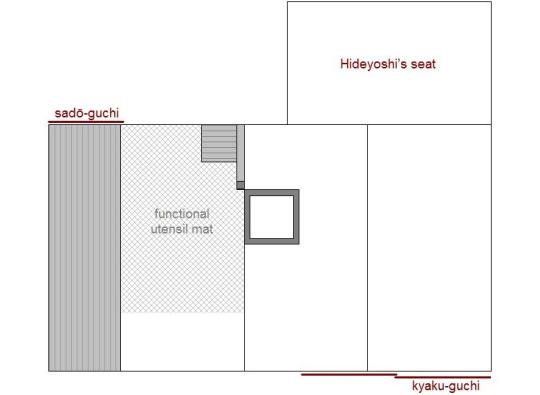
As an aside, Jōō’s and Rikyū’s small rooms had the guests enter through a pair of shōji panels which, while not full size, were still significantly higher than even the highest of the “classical” nijiri-guchi (which is the one installed in the Tai-an) -- meaning that there was no need to shuffle through the entrance in this way, nor any danger of accidentally elevating the torso too soon (and so hit the back of one’s head on the lintel of the door). The configuration of Rikyū’s actual Tai-an [待庵] is shown above.
Regarding the nijiri-guchi found on the Tai-an today, this was originally Rikyū’s naka-kuguri [中潜り], the sliding wooden door through which the guests stepped when passing into the fully enclosed inner-roji. In Rikyū’s rooms, the inner-roji was a small courtyard containing the chōzu-bachi and a roofed-over platform-like veranda (sometimes little more than a bench, though occasionally as large as one-mat in size) on which the guests sat during the naka-dachi (and by means of which they entered the tearoom by passing through the shōji that adjoined it).
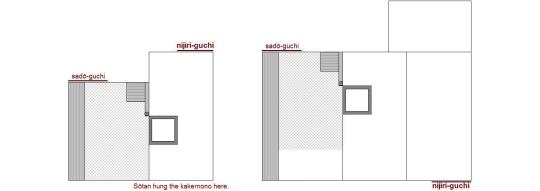
The naka-kuguri was installed as the nijiri-guchi by Sōtan’s son Kōshin Sōsa, when he remodeled the Tai-an so that it would more closely resemble Sōtan’s Fushin-an [不審庵] (shown above, on the left). Kōshin’s modifications to Rikyū’s Tai-an are shown on the right, with the way it was derived from Rikyū’s room is documented in the drawing below.

While Kōshin retained Rikyū’s original three-mat configuration, he reduced the width of the ita-datami onto which the original sadō-guchi opened, from Rikyū’s 1-shaku 8-sun 5-bu to the present 8-sun -- since this was the width of the ita-datami in Sōtan’s Fushin-an (even though the Fushin-an was, at that time, a 1-mat daime room). Reducing the width of the ita-datami necessitated a corresponding reduction of the width of the toko (in order to retain the same spatial configuration of the preparation area that functioned as the room’s mizuya), with its depth adjusted accordingly in order to maintain the Sen family’s preferred proportions.
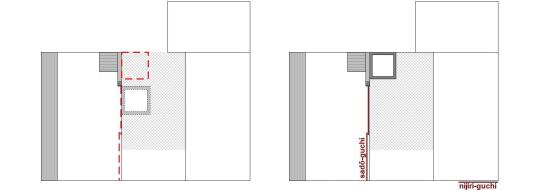
The complete repudiation of the original utensil mat, effected by erecting a pair of fusuma between the naka-bashira and the lower end of the mat, thereby turning Rikyū’s 3-mat room (that was used like a 2-mat daime) into the current 2-mat format, incorporating a sumi-ro of non-standard size (the ro that was used was the one that was supposed to be used in an inakama room, which tends to belie the argument that the person responsible for these changes was an expert in the Nampō Roku, as he claimed), occurred during the nineteenth century -- with the intention of making the room appear different from Omotesenke’s Fushin-an (primarily because the person who effected the changes had an intense personal animosity toward Omotesenke).

The only authentic portion of the present Tai-an is the tsuri-dana, and the sode-kabe (the wall on the right side of the photo) to which it is attached.
Rikyū’s tsuri-dana (the Tai-an was the first daime room that featured a tsuri-dana) had only a single shelf, as seen here; the tsuri-dana with two shelves was proposed (several years later) by Furuta Sōshitsu, while the one with three shelves was subsequently devised by Kobori Masakazu early in the seventeenth century. Rikyū’s sode-kabe lacked the fenestration at the bottom of the wall (this was another of Oribe’s creations, and one that is considered an important feature of the arrangement today). The wall on the far side of the tsuri-dana (to which the tsuri-dana is not attached) seems to have been replastered when the sadō-guchi was moved closer to the tsuri-dana (this became necessary when Kōshin Sōsa reduced the width of the ita-datami to 8-sun: the original sadō-guchi had opened fully onto the ita-datami, which Rikyū used as a sort of runway by means of which he walked to the lower end of the utensil mat, from where he bowed and greeted Hideyoshi at the beginning of his temae).
The rest of the room has been changed completely from anything that Rikyū himself would have recognized.
That said, if you search through the literature, you will find innumerable tomes by famous scholars that explain how Rikyū created and used the 2-mat room with its 1-shaku 3-sun sumi-ro [隅爐] (in other words, the room as it exists today, which is how it was reconstructed in the nineteenth century), all of whom will be very happy to discredit me and what I have written above with a red-faced vehemence. I first arrived at these conclusions, nevertheless, after a very, very careful and multi-yeared study of the measurements of the Tai-an -- since the wall between the sumi-ro and the tsuri-dana can only be interpreted as a sode-kabe, according to Rikyū’s own teachings on these measurements. Many years later, I also found the same argument made by the eminent Japanese art historian and scholar Ōkōchi Nobutake [大河内信威; 1902 ~ 1990] (in cultural matters, he is also known as Ōkōchi Fūsenshi [大河内風船子]), who carefully explored the evolution of this room in his own writings.
I decided to mention all of this here, even though it has nothing to do with the no-gaki no chakai, because it is an example that the reader should always keep in mind when listening to, or reading, the explanations of classical matters as interpreted by the modern schools and their affiliated scholars: the evidence in support of their assertions will usually be mountainous (yet a careful look will generally reveal that most of those books were written by the same small circle of proponents); but even if everyone is intent on arguing that a certain thing is true, that does not mean that it is necessarily historically factual. The schools, for all the arguments that they frame in such a way so as to suggest the contrary, are businesses; and, because chanoyu is a traditional activity, the way they strive to enlist new students is by claiming that they -- and they alone -- are the true and authentic representatives of the tradition. This is why, on the one hand, they burn incense to Rikyū, and swear by the veracity of the Nampō Roku (when something -- usually something in Book Seven -- supports their claims), and then zealously disavow his (historically authenticable) teachings as lies and fabrications (when they conflict with that school’s preferred way of doing something), on the other. The first six books of the Nampō Roku are largely true; and Book Seven is largely spurious.
³Seijō-keppaku wo moto to su [淸淨潔白ヲモトヽス].
Seijō-keppaku [淸淨潔白] means something like (be) pure in thought and deed*. It is a Buddhist aphorism, of the sort that became popular during the Edo period (the phrase is found in a text known as the Yo-ji juku-go [四字熟語], which was being used in the temple-schools to teach students to read kanji†).
Here it means that this idea of purity in mind and body is central (or, as it says, the fundamental principal -- moto [本]) to the no-gake. Perhaps because, historically speaking, no-asobi [野遊] seems to have not infrequently degenerated into a licentious sort of escapade (given that the area was usually surrounded by curtains -- rather like a boudoir -- and protected by a company of guards who all faced outward). __________ *Kotobank (jp) explains the phrase in this way:
kokoro ga utsukushiku, okonai ni ushiro kurai-tokoro ga nai koto
[心が美しく、行いにうしろ暗いところがないこと].
This means “be noble and pure in heart, and have nothing dark in anything that you do.” Kurai-tokoro [暗い所] literally means a dark place (and could be understood in a similar way to the modern idiom “being in a dark place”). In a Buddhist context, this darkness usually suggests ignorance (of the True Way), being misguided, being deluded; a state of intellectual morbidity, rather than evilness of purpose. In other words, it is the antithesis of the clear-eyed state of enlightenment.
That said, in the context of the present entry, the expression seijō-keppaku is being used in a more mundane sense -- that is, when participating in a no-gake no chakai, we should keep our mind focused on what is pure, rather than allowing ourselves to be distracted by carnal thoughts or desires (as discussed in the second paragraph).
†I have been unable to find any reference to when this particular text was first used in Japan.
Books of this sort had been used in Korea since at least the Goryeo period, and remained popular tools (especially in the clan-based schools that were set up on the grounds of their Ancestor shrines) well past the middle of the 20th century. Many books of this sort (that show the influence of the Korean neo-Confucian-infused Buddhism) began to arrive in Japan beginning in the early Edo period (starting with Taku-an Sōhō [澤庵宗彭; 1573 ~ 1645], who arrived in Japan in 1603 -- according to Kanshū oshō, who was his direct descendant), though the book could have been brought to Japan earlier.
Taku-an’s intention was apparently nothing less than to undertake the reformation of Japanese Buddhism.
⁴Daizenji-yama, mata ha Chikuzen no Hakozaki-matsubara ni te Kyū no hataraki ni, matsukage naru-yue matsuba wo kaki-yose sawa-sawa to yu wo wakashi [大善寺山、又ハ筑前ノ箱崎松原ニテ休ノハタラキニ、松陰ナルユヘ松葉ヲカキヨセサハ〰ト湯ヲワカシ].
Daizenji-yama [大善寺山] is an area south of Fukuoka City, between the central mountains and pine barrens of the Chikugo river delta and the coast of the Ariake bay (or sea). The name suggests that, at some point in the past, a famous temple had existed in the region; but all physical traces of this institution have long been lost (the actual site of the temple complex seems to have been unknown in Rikyū’s day; and remains so today as well). The area had been under cultivation since ancient times (since the area had been part of the Gaya kingdom -- perhaps the original rice fields had been established by the Daizen-ji, or were being farmed under its purview), though apparently it had returned to the condition of a moorland by the time (in 1586~7) that Hideyoshi was prosecuting his campaign against the clans of Kyūshū -- in his efforts to incorporate the island into the Japanese nation.
Chikuzen no Hakozaki-matsubara [筑前の箱崎松原] refers to an area, now part of Fukuoka City north-east of the central business and political districts, that had originally been part of the extensive grounds of the Hakozaki-gū [筥崎宮], the important Shintō shrine dedicated to the God Yawata-no-kami [八幡神]*, the apotheosis of the semi-mythical emperor Ōjin [應神天皇].
Kyū no hataraki ni [休の働きに] means the subsequently related details (of raking the pine-needles into a mound that was then set ablaze and used to heat the kama) were Rikyū’s original idea.
Matsukage naru-yue matsuba wo kaki-yose [松陰なるゆえ松葉を掻寄せ] means because the site (selected by Rikyū for this more-or-less impromptu chakai) was in dappled shade beneath the pines, pine-needles were raked up.... The dappled shade implies that the area was forested with pine trees, under which would naturally be found a deep layer of pine-needles covering the ground. Wherefore it was perfectly natural for Rikyū to use them as fuel†, rather than charcoal.
Sawa-sawa to yu wo wakashi [爽々と湯を沸かし]: sawa-sawa to [爽々と]‡ means understandably, logically; yu wo wakashi [湯を沸かし] means to boil the hot water.
Though Shibayama’s text writes matsukage [松陰] as matsukage [松蔭], and wakashi [ワカシ = 沸カシ] as wakashi [湧シ], these are simply alternate ways of writing the same kanji-compounds. The sentences themselves are identical. __________ *Now his name is usually pronounced Hachiman-jin [八幡神].
†By raking the needles into a mound, Rikyū exposed the damp ground in a circle around the fire. Doing so helped to prevent the fire from spreading out of control.
‡Sawa-sawa [爽々] is also used to mean refreshing, and also to mean clearly, unambiguously. While it seems that many commentators lean toward refreshing (because the text is describing an outdoor chakai), the context seems to demand understandably, intelligibly, or logically -- the idea to simply rake up a pile of pine-needles to use as fuel would follow naturally from the fact that the ground under the pine trees would be thick with pine needles.
⁵Waki-tatetaru shōfu no hito-koe, keburi no tachi-noboru-tei omoshiroshi-tote [ワキ立タル松風ノ一聲、烟ノ��ノボルテイ思白シトテ].
Waki-tatetaru shōfu no hito-koe [沸き立てたる松風の一聲] means when the boiling water raises its voice in the pine-wind(-sound)....
Kemuri no tachi-noboru-tei [烟の立ち上る躰]: kemuri [烟] means smoke, fumes (because only the top layer of pine needles are completely dry, the incorporated moisture will color the smoke white or pale-gray); tachi-noboru [立ち上る] means (the smoke) rises straight up; tachi-noboru-tei [立ち上る躰] means the smoke appears to rise like a pillar*.
Omoshiroshi [思白シ] appears to be either a miscopying, or one of those weird Edo period usages (where unexpected kanji were used as a way to confuse the uninitiated). The word should be omoshiroshi [面白シ] -- which would be omoshiroi [面白い] (“very interesting” or “very amusing”) today.
Shibayama’s version, other than exhibiting the same sort of kanji variants mentioned in the previous footnote, is identical to what is found in the Enkaku-ji manuscript. __________ *This is all poetically fanciful.
Beneath pine trees, the smoke tends to spread out like a light mist, since the bows of the trees themselves create a very stable microclimate of still air. This is what shōfū [松風], “pine wind,” actually means: the air on the ground (and, indeed, up to the upper branches of the pine trees) is completely still and silent, so that one hears the wind blowing across the tops of the pines from a distance (which is a completely different sensual experience from being within the blowing wind itself).
⁶Denka sono-nochi no-asobi no on-toki ha, tabi-tabi, Kyū ni mo, Sōmu, Sōkyū ni mo, ka no fusube-chanoyu wo dashi-sōre to ōserare-shi yori, mina-hito fusube-chanoyu to iu-koto nari [殿下其ノチ野遊ノ御時ハ、タビ〰、休ニモ、宗無、宗及ニモ、カノフスベ茶ノ湯ヲ出シ候ヘト被仰シヨリ、皆人フスベ茶湯ト云コト也].
Denka [殿下] means “his highness” -- that is, Hideyoshi.
Denka sono-nochi no-asobi no on-toki ha [殿下その後野遊の御時は] means “after that his highness, on subsequent occasions when he was indulging in an outing (into the wilds)....”
Kyū ni mo, Sōmu, Sōkyū ni mo [休にも、宗無、宗及にも] names three of Hideyoshi's sadō [茶頭], tea officials, who appear to have attended upon him during excursions of this sort. In addition to Rikyū, these were Sumiyoshi-ya Sōmu [住吉屋宗無; ? ~ 1595]* and Tennōji-ya Sōkyū [天王寺屋宗及; ? ~ 1591]. All three men were prominent machi-shū chajin from Sakai.
Tabi-tabi...ka no fusube-chanoyu wo dashi-sōroe to ōserare-shi yori [度々...かの燻べ茶の湯を出し候えと仰せられしより] means “from time to time... this kind of ‘smoky chanoyu’ would be performed† when called for‡....”
The phrase ka no fusube-chanoyu [かの燻べ茶の湯] is important, because it means that Hideyoshi was requesting them to perform exactly the same kind of tea service that Rikyū spontaneously improvised on the earlier occasion -- that is, heating the kama by means of burning a mound of pine needles (rather than charcoal) underneath.
This suggests that it was Hideyoshi who either coined, or else was responsible for popularizing, the expression “fusube-chanoyu.”
Mina-hito [皆人] means all of the people, everyone. This expression appears to have been somewhat antiquated (at least by the eighteenth century).
Mina-hito fusube-chanoyu to iu-koto nari [皆人燻べ茶の湯と云うことなり] means “(based on that,) everyone started to call (no-gake) fusube-chanoyu.”
Here Shibayama's version has several very minor changes: denka sono nochi no-asobi-tō no seki ni te ha, tabi-tabi Kyū ni mo, sono-hoka Sōmu, Sōkyū ni mo, ka no fusube-chanoyu wo dashi-sōroe to ōserare-shi yori, hito mina fusube-chanoyu to iu nari [殿下其後野遊等ノサキニテハ、度〻休ニモ、其外宗無、宗及ニモ、カノフスベ茶湯ヲ出シ候ヘト被仰シヨリ、人皆フスベ茶ノ湯ト云フナリ].
Denka sono-nochi no-asobi-tō no seki ni te ha, tabi-tabi Kyū ni mo, sono-hoka Sōmu, Sōkyū ni mo, ka no fusube-chanoyu wo dashi-sōroe to ōserare-shi [殿下そののち野遊等の席にては、度〻休にも、その外宗無、宗及にも、かの燻べ茶の湯を出し候へと仰せられし] means “afterward, when his highness was indulging in pastimes such as outings, in those places he occasionally called out for [Ri]kyū, or the others -- Sōmu and Sōkyū -- to please bring out ‘that fusube-chanoyu.’” This qualifies that when Hideyoshi was calling out for fusube-chanoyu, his intention was that it be served on the spot, wherever he was (rather than having the party move to some other location that had been prepared beforehand).
Hito mina [人皆] (which reverses the two kanji so that we have “the people, all of whom...”) produces the same meaning. To iu [と云う] means “(they) said,” “(they) called (it);” to iu-koto [と云うこと] (as found in the Enkaku-ji manuscript) means “the situation where (they) said,” “the case where (they) called (it)....”
These changes will not have any impact on the meaning in English. __________ *With respect to Sumiyoshi-ya Sōmu, his family business was the brewing of sake; and he had been initiated into the practice of chanoyu by Jōō (even though he was said to have been six or seven years younger than Rikyū).
He trained in Zen under Shun-oku Sōen [春屋宗園; 1529 ~ 1611].
†Dashi-sōroe [出し候え] more literally means “please bring out and do” (as in something that is brought out from one’s “bag of tricks”) -- something that is being held in readiness, so it can be enjoyed on the spur of the moment.
‡Ōserare-shi [仰せられし] means to call upon, or order (an underling) to please do something. In other words, on those occasions when Hideyoshi, spending the day hawking, or indulging in some other such pastime, he would occasionally order Rikyū, Sumiyoshi-ya Sōmu, or Tennōji-ya Sōkyū (whichever of these men were attending on him at that time -- all three were members of the group of eight chajin referred to as o-sadō hachi-nin-shū [御茶頭八人衆], whose function was to take charge of all tea-related matters on behalf of Hideyoshi) to serve tea in this way. (Which is why they would always have to be prepared -- since to have to send back to the base camp outside of Hakata for tea and utensils would have offended Hideyoshi severely.)
The o-sadō hachi-nin-shū [御茶頭八人衆] consisted of Imai Sōkyū [今井宗久], Tennōji-ya Sōkyū [天王寺屋宗及], Sen no Rikyū [千利休], Yama-no-ue Sōji [山上宗二], Jū Sōho [重宗甫], Sumiyoshi-ya Sōmu [住吉屋宗無], Mozu-ya Sōan [萬代屋宗安], and Sen no Dōan [千道安; who was also referred to as Shōan or Jōan, 紹安].
⁷Daizenji-yama ni te ha, shimo-michi no minami itchō-bakari, Hakozaki ni te ha Ebisu-dō no tō-hoku yon・go-chō, o-chasho wo kamae, matsu ni unryū-gama wo tsuri, chabako wo hiraku to Kyū no oboe-gaki ni mo ari [大善寺山ニテハ、下道ノ南一町バカリ、箱崎ニテハヱビス堂ノ東北四・五丁、御茶所ヲカマヘ、松ニ雲龍釜ヲツリ、茶箱ヲヒラクト休ノヲホヘ書ニモアリ].
Daizenji-yama ni te ha, shimo-michi no minami itchō-bakari [大善寺山にては、下道の南一町ばかり]: Daizenji-yama ni te [大善寺山にて] means in the (region of) Daizenji-yama; shimo-michi [下道の南一町ばかり] refers to lower of the two the ancient post roads that connected Daizaifu [太宰封] (the ancient capital of Gaya) with the port on the Bay of Ariake -- many years ago I was told that the modern Tenjin-Omuta Line basically follows the course of that road (while the shinkansen follows the upper road); shimo-michi no minami itchō-bakari [下道の南一町ばかり] means 1-chō (a measure of distance of around 109 meters, so a square of roughly that size would have been curtained off) south of the post road*.
Hakozaki ni te ha Ebisu-dō no tō-hoku yon・go chō [箱崎にては惠比須堂の東北四・五町] means an area of 4- or 5-chō to the north-east of the Ebisu-dō† -- this is a reference to the Tamatori Ebisu-jinja [玉取恵比須神社], one of the shrines within the greater Hakozaki-gū: it was located on the north-eastern edge of the complex. In Rikyū’s day, the entire area surrounding the Hakozaki-gū was covered by an ancient pine-barren, so what this means is that an area of some 4- or 5-chō (roughly half a kilometer square) was enclosed by curtains, to establish Hideyoshi’s tea-drinking area.
O-chasho wo kamae [御茶所を構え] means (Hideyoshi's) place for (drinking) tea was enclosed in the manner shown in the photo, below‡ -- in other words, areas of the sizes mentioned in the above descriptions were enclosed by hanging red and white striped curtains around the periphery (with guards stationed on the outside, to provide security).
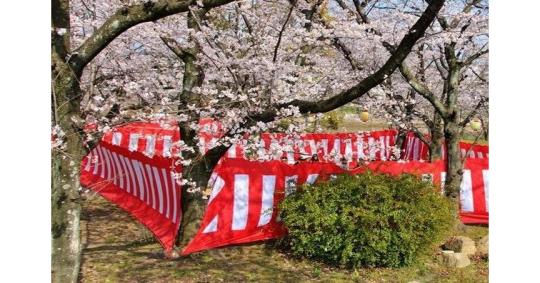
Matsu ni unryū-gama wo tsuri, chabako wo hiraku to [松に雲龍釜を釣り、茶箱を開くと] means the unryū-gama was hung from a pine tree, and a tea-box was opened (to reveal the utensils it contained).
Rikyū’s cha-bako is shown below.

This box measures approximately 8-sun by 5-sun, and is 4-sun 5-bu high. It appears to have been made in Thailand. It would have been imported for use as a te-bako [手箱] (a box small enough to be carried in the hands, in which people like courtiers -- both men and women -- carried their cosmetics, and other small items that they might need throughout the day when on court duty). When used for serving tea, the box (which contained the chawan, prepared with chakin, chasen, and chashaku already arranged in it, together with the chaire, tied in its shifuku) was simply opened, and the utensils it contained lifted out and arranged on thin pieces of wood that were spread out on the ground to receive them. There was nothing resembling a modern cha-bako temae; and tea would have been served in the usual way.
If a stream flowed through the enclosure (as there was, at least, in the Daizenji-yama o-chasho), the kama would be filled directly from the stream -- which would also take the place of a mizusashi (and koboshi)**.
Kyū no oboe-gaki ni mo ari [休の覺書にもあり] means that a discussion of the fusube-chanoyu will also be found in the Book One of the Nampō Roku -- the Oboe-gaki [覺書] book that memorializes some of Rikyū’s stories and teachings††. This reference, however, is a little confusing, since it implies that the Oboe-gaki book was written by Rikyū, where it is actually a record of Nambō Sōkei’s recollections -- while most of the things discussed in Book One are related to Rikyu and his teachings, this is not true of everything.
For the last part of this sentence, Shibayama’s toku-shu shahon has matsu ni kusari ni te unryu-gama wo tsuri, chabako wo hiraku to, Kyū no oboe-gaki ni mo ari [松ニクサリニテ雲龍釜ヲツリ、茶箱ヲヒラクト、休ノ覺書ニモアリ].
The only difference is that this version qualifies that the unryū-gama was suspended from the pine tree on a chain (kusari [鏁]) -- which would be much easier to carry than a take-jizai [竹自在] (even though it would be “less wabi” than the latter). __________ *The old post road ran roughly east to west in this area. The most likely location would have been on the bank of the Hiro-kawa [廣川], or one of its tributaries (since this would have eliminated the need for a mizusashi).
As this gathering was completely impromptu, Rikyū, Hideyoshi, and the other members of their party, would have squatted down on the ground, and prepared and drunk tea in that way.
†Ebisu [惠比須] was the Shintō god of fishing and commerce (enterprises that took place on the open ocean). As such he was of great importance to the townsmen of both Sakai and Hakata.
Ebisu [夷], as it is written in Shibayama's toku-shu shahon, is one of several hentai-gana ways to render the name of this God.
‡This was done by hanging red and white striped curtains (called kō-haku no maku [紅白の幕]) around the periphery. A phalanx of Hideyoshi's personal guards would have been stationed on the outside of these curtains, to provide the occupants with security. (Remember, Nobunaga met his untimely end because he did not have adequate security surrounding the Honnō-ji when indulging in chanoyu.)
**The host’s seat would be oriented so that, crouching down near the ground, he would be facing upstream, on the bank of the river. Cold water would be dipped directly from the river using a hishaku -- and used water would be poured into the river, too (which is why the host’s orientation was so important).
††Please refer to the two posts that were cited (and linked) in the first sub-note under my introductory remarks, immediately following the translation.
⁸Tadasu ni te no toki ha, yashiro [h]e mairu naka-michi, ko-matsubara no ryū no atari nari [タヾスニテノ時ハ、社ヘ參ル中道、小松原ノ流ノ邊也].
Tadasu [糺] is a reference to Tadasu no mori [糺森] (the Grove of Rectification), a wooded area located just north of the confluence of the Takano and the Kamo rivers, within the precincts of the Lower Kamo Shrine (Shimo-gamo-jinja [下鴨神社]), in Kyōto, where a no-gake chakai was hosted by Rikyū in 1587.
Tadasu ni te no toki [糺にての時は] means on the occasion when (the chakai was hosted) in the Tadasu(-no-mori)....
Yashiro [h]e mairu naka-michi, ko-matsubara no ryū no atari nari [社へ參る中道、小松原の流の邊なり] means on the middle of the paths leading to the shrine, (Rikyū served tea) beside the small stream that flows through the grove. This rill (ryū [流]) is seen in the photo*.
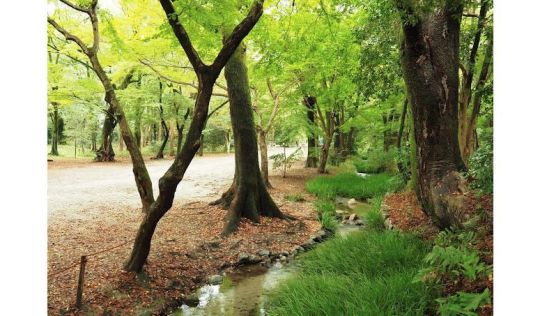
This is referring to a chakai that Rikyu hosted at dusk on the last day of the Sixth Lunar Month of Tenshō 15 [天正十五年六月晦日]† (August 3, 1587), which was the 29th day of that month, the day of preparation for the Kamo festival. __________ *It was probably because of the small size of the stream, and the fact that the stream flows first through the shrine itself (with many people having been passing through the grounds on that day of preparation), that Rikyū chose to bring water in a sugi te-oke [杉手桶], rather than dip it straight from the stream. (The fact that the chakai would take place in the evening may have also figured into his calculations, since exposed water was said to become poisonous after dark.)
†Please see the post entitled Nampō Roku, Book 2 (42): (1587) Sixth Month, the Last Day, Evening for illustrations of the various utensils that Rikyū used, as well as other details of that occasion. The URL for that post is:
https://chanoyu-to-wa.tumblr.com/post/183858107433/namp%C5%8D-roku-book-2-42-1587-sixth-month-the
This gathering was likely cited here (as a way to give veracity to his assertioins) because the author of this entry had no other information regarding Rikyū’s activities -- but what could be found in the Nampō Roku itself.
⁹Sono-toki made ha matsu mo nashi, san-bon take ni te kama-kakerare, mizu-chikaki yue, mizusashi nashi ni hataraki tamau nari, chakin kama no futa ni okare-shi-koto wo, aru hito toi-keru ni, kono ichi-e no kokoro ha sayō no koto ni te ha nashi [其時マデハ松モナシ、三本竹ニテ釜カケラル、水近キユヘ、水サシナシニハタラキ玉フ也、茶巾釜ノフタニヲカレシコトヲ、アル人問ケルニ、コノ一會ノ心ハサヤウノコトニテハナシ].
Though it would have been easy to divide this very long sentence into several separate footnotes, I hope my reasons for dealing with it as a unit will become clear as you read the commentary.
Sono-toki made ha matsu mo nashi [その時なでは松もなし] means “up to that time, if there were no pine trees (from which the kama could be suspended)....”
San-bon take ni te kama-kakerare [三本竹にて釜懸けらる] means “the kama may be hung from three lengths of bamboo.”
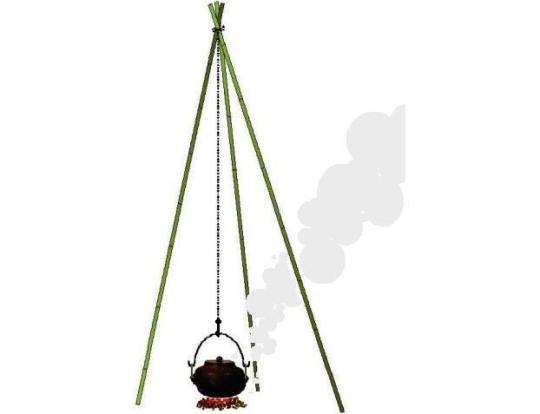
A structure like this had been used since ancient times to create stands for kagari-bi [篝火] (garden lights -- the word is sometimes translated garden torches or garden flares -- consisting of a metal basket filled with burning brushwood). While this basket was placed in the crotch above the three poles, here the kama was suspended below them, with the fire kindled in the middle of the tripod. This was probably the first way that the kama was arranged for no-gake (hence its name) -- with the kama being suspended from a pine tree appearing much later (it is certainly possible that the episode at Daizenji-yama mentioned above was the first such occasion for this arrangement).
Mizu-chikaki yue, mizusashi nashi ni hataraki tamau nari [水近いゆえ、水指なしに働き給うなり] means if water (is flowing) nearby, it is said that you can do things without a mizusashi....”
Chakin kama no futa ni okare-shi-koto wo [茶巾釜の蓋に置かれしことを] means “...in which case the chakin should be placed on the lid of the kama.”
Aru hito toi-keru ni, kono ichi-e no kokoro ha sayō no koto ni te ha nashi [ある人問けるに、この一會の心業ようのことにてはなし] means “when a certain person asked about this, (questioning) the thinking behind the way things were done at this one gathering, with respect to that (matter)*, (he suggested that) it should not have been done.”
In other words, this person has taken offense, since he believed that placing the chakin on the lid of the kama was something that should only be done when that chakin would not be used again (in other words, when the chakin was being “thrown away” -- as per the arguments made in entry 64). Yet on this occasion, when there was no mizusashi, Rikyū placed the chakin on the lid of the kama over the course of the whole temae. That is, the quisitor is implying that Rikyū either made a foolish mistake, or was being disrespectful of the proprieties. In the Enkaku-ji version of this story, Rikyū does not actually make any reply.
Shibayama’s text is the same except for the final phrase in this sentence. His toku-shu shahon ends the sentence: aru-hito toi-keru ni, kono ichi-e ni oite ha susugi-kiyomuru-koto cha-gu nomi narazu [或人問ケルニ、此一會ニ於テハスヽキ淸ムルコト茶具ノミナラズ]. So, rather than questioning why the chakin could be placed on the lid of the kama throughout the temae, here his interlocutor seems to be asking about the matter of purifying the utensils (the chawan, chakin, and chasen) by rinsing them in water. To this comes the reply (whether from Sōkei or Rikyū is not clear in this version): “it is not only the utensils that should be rinsed so they are pure†.” (Implying that the idea of purity extends also the the mind of the host and his guests.)
However, here Tanaka’s genpon text developes this idea even further. The whole sentence that we are considering in this footnote is given as follows: sono-toki made ha matsu mo nashi, san-bon take ni kama kakeraru, mizu chikaki yue ni, mizusashi nakereba, chakin wo kama[-no-]futa no ue ni oku wo tori-mama kama no futa ni okaruru, sono shisai toi-bito ari, Kyū no iu, kono ichi-e ni oite, susugi-kiyomuru-koto, chagu nomi narazu [其時マデハ松モナシ、三本竹ニテ釜カケラル、水近キ故ニ、水指ナケレバ、茶巾ヲ釜蓋ノ上ニヲクヲ取マヽ釜ノフタニヲカルヽ、其子細問人アリ、休ノ云、コノ一會ニ於テ、スヽキ淸ムル事、茶具ノミナラズ].
This means: “if, on that occasion, there were no pine trees, the kama would be hung from three lengths of bamboo; and if, because [flowing] water is [available] nearby, and so a mizusashi has been dispensed with, the chakin is placed on the lid of the kama, used as it is‡, and then put back on the lid of the kama [afterward]. Someone asked about the details of this, to which [Ri]kyū replied: ‘in this particular gathering, with respect to the matter of purifying [the utensils] through rinsing [them], it was not only the things that were used to prepare tea [that were so purified].’”
Rikyū’s explanation seems to be that it is not only the utensils that should have been cleaned, but also the minds of the host and guests as well. When their minds have been purified, they are no longer contaminated by the dust of the world. So, being pure, they perceive the world as pure -- thus, for such people, the question of purity and defilement ceases to exist. The lid of the mizusashi is not especially pure, nor is the lid of the kama unclean**. Both are extensions of this pure world, so the lid of the kama will be as pure as everything else. __________ *The reference seems to be to using water dipped from the stream, in place of a mizusashi.
The actual thinking is unclear, but the author appears to have been misinformed about Rikyū’s evening chakai in the Tadashi-no-mori, if that is the fusube-chakai to which he is referring -- because, for whatever reason, Rikyū chose to bring the water in a sugi-teoke, rather than dipping it out of the stream, and so used the sugi-teoki as his mizusashi during that gathering.
As explained in the previous footnote, this stream is rather small, and flows through the shrine before passing through the Tadasu-no-mori (and eventually being discharged into the Kamo River at the end of the little peninsula on which the shrine is located). Thus, Rikyū may have felt that the water in the stream would not be especially pure (in that time it was not unusual for men to urinate freely into any stream or gutter when necessary, which is why residences in Kyōto erected arching bamboo grates along their street-facing walls -- to keep men a safe distance away -- since urine would cause the plaster to break down).
Furthermore, as was also mentioned above, he may have felt that exposed water becomes charged with poisons after dark, making it unsafe to use regardless of the civic-mindedness of the local population. (The water in the sugi-teoke would have been drawn at dawn; and the cryptomeria wood from which the bucket was fabricated was understood to be purifying of the contents as well.)
That all being said, the point appears to be that the author of this entry imagined that Rikyū did not use a mizusashi on that occasion, and so placed the chakin on the lid of the kama throughout the whole temae -- and it was this behavior that the quisitor was rejecting (phrasing his objection as a question).
†Implying that the purity of the utensils should be our least concern (even though they should be spotlessly pure as a matter of course). The importance of a pure heart is one of the central themes in writings about chanoyu theory, an aspect of chanoyu that was being emphasized during the first half of the Edo period, in the wake of Taku-an Sōhō’s teachings on the relationship between Tea and Zen.
At this point in his commentary, Shibayama directs our attention to the text of the original entry (cited above under the introductory notes) in Book One, which reads, in part: shu-kyaku no kokoro mo sei-jō keppaku wo dai-ichi to su iu-iu [主客ノ心モ淸淨潔白ヲ第一トス云〻]. This means “with respect to the hearts of both the host and (his) guests, it is said that they should be pure in both thoughts and deeds” (please refer to the discussion of sei-jō keppaku [淸淨潔白] in footnote 3, above).
Furthermore, he goes on, in entry 19 in the Sumibiki no uchinuki-gaki・tsuika [墨引之内拔書・追加], it says: chakin, chasen ika ni mo mizuke no sawa-sawa to miyuru-yō ni shite iu-iu [茶巾、茶筌イカニモ水ケノサハサハト見ユル様ニシテ云〻]. This means “as for the chakin and chasen, always make them appear fresh and clean [by rinsing them] with water -- so it has been said.”
‡More literally, tori-mama kama-no-futa ni okareru [取りまま釜の蓋に置かれる] would mean taken up as it is, and (then) placed on the lid of the kama (afterward). In other words, in the absence of a mizusashi, the chakin is placed on the lid of the kama at the very beginning of the temae (when the host is emptying the chawan of the chasen and chakin, in preparation for the first rinsing and chasen-tōshi), and then taken up from there (when it is needed to dry the chawan) and returned there afterward.
Again, this is describing the temae in Sen family terms (where the lid was handled with the bare fingers). In Rikyū’s temae, as has been explained before, the chakin was used to protect the fingers when lifting off the hot lid, and then rested on the lid immediately.
But this would then raise the question of what to do with the chakin when the lid of the kama was closed (during the chasen-tōshi) so as to heat the water fully in anticipation of the preparation of koicha. Of course, in the case of the evening chakai in the Tadashi-no-mori that is cited as an example, Rikyū used a sugi-teoki as his mizusashi (rendering this question moot); but in the absence of a mizusashi -- such as when Rikyū was called upon to spontaneously spontaneously serve tea during Hideyoshi's outing to Daizenji-yama -- perhaps Rikyū only served usucha (which would make the closing and reopening of the lid of the kama unnecessary). Indeed, during such an outing (which was probably for hawking, one of Hideyoshi’s favorite outdoor activities), koicha would have been inappropriate, since the idea was to quench Hideyoshi’s thirst -- which would account for Hideyoshi’s impressed surprise at the way Rikyū chose to do things (and why he subsequently called out for “fusube-chanoyu” on other occasions of the sort).
**This idea that the lid of the kama is inherently unclean appears to be unique to the machi-shū tradition espoused by the Sen family (I have heard it said there, but it is not included in the teachings of those schools that do not have such a connection). As was explained in entry 64, Rikyū used the chakin to protect his fingers when opening the lid of the kama, and it remained resting on the lid until it was time to close it again. This was the gokushin way of doing things -- and this established the precedent that he used on occasions when there was no mizusashi.
¹⁰Isshin no sho-i ni shite, te-waza no shōji ni arazu, mazu yoku-tanren no ue, monjin-serare-yo to no tamau [一心ノ所爲ニシテ、手ワザノ小事ニアラズ、先能煆煉ノ上、問訊セラレヨトノ玉フ].
Sho-i [所爲] means an action, a deed. So isshin no sho-i ni shite [一心の所爲にして] means to do something with one’s whole heart*.
Te-waza no shōji ni arazu [手業の小事にあらず]: te-waza [手業] means something that is done with one’s own hands (i.e., a physical effort); shōji [小事] means trivial, insignificant. So, “what we do with our own hands is not unimportant.”
When we do something wholeheartedly, our actions can never be trivial: even the most insignificant gesture will be full of power.
Mazu yoku-tanren† no ue, monjin-serare-yo to no tamau [先ずよく鍛練の上、問訊せられよとの給う]: mazu [先ず] means first, right away; yoku-tanren no ue [よく鍛練の上] means advanced beyond a state of mastery‡; monjin-serare-yo [問訊せられよ] means (you) should question (your own capabilities); to no tamau [との給う] means (this teaching) has been handed down (to us).
Here, Shibayama’s and Tanaka’s texts include only the first phrase (isshin no sho-i ni shite [一心ノ所爲ニシテ]), after which they launch off in a different direction (their version -- which is discussed in footnotes 11 and 12 -- has been included in the translation of the entry, enclosed in doubled brackets). __________ *Shibayama argues that this is the main idea that underpins the (successful) staging of a no-gake no chakai.
Here he again quotes from entry 32 in Book One to support this contention: shutsuri no hito ni arazu shite ha nari-gatakaru-beshi [出離ノ人ニアラズシテハ成ガタカルベシ] -- which means, “if one is not [like] a person who has renounced the world, aspiring to [stage a no-gake no chakai] should be all but impossible.” This reflects the state of chanoyu theory (which developed in response to Takuan Sōhō’s teachings, as discussed above) that was popular among the machi-shū followers of the Sen family around the end of the seventeenth century.
†In the entries that were written by the author of the present section (who appears to have been affiliated with the Sen family’s machi-shū tradition of chanoyu), tanren [鍛練], which refers to training or discipline (in the sense of one’s level of skill or mastery of the practice), is invariably written tanren [煆煉]. The reader should be careful, therefore, when approaching the original texts, because this unrecognized variant may prove confusing (since most dictionaries do not recognize the equivalency between these two written forms).
‡In other words, once we have mastered everything (at least at our level), we should immediately look back and reflect on our attainments, questioning whether we truly understand.
This reflection and self-criticism was considered especially important around the time that this entry was written (in the late seventeenth century).
¹¹Hito-bito no kokoro tomo ni aka ha aru-majiki ni, sono fushin dai-no-kegare nari [人〻ノ心共ニ垢ハアルマシキニ、其不審大ノケガレナリ].
This and the following sentences (footnote 12) are found only in the toku-shu shahon and genpon versions of the text.
Hito-bito no kokoro tomo ni aka ha aru-majiki [人々の心ともに垢は有るまじき] means the hearts of all people should not be sullied.
Sono fushin [その不審] means to be ignorant of that (principal)....
Dai no kegare nari [大の穢れなり] means (this ignorance is) a grave disgrace.
¹²Ji ni okite mo kegare ha naki hazu no shōjō-shin ni nari-sōrō ha de ha, kono ichi-nen no kokoro ha satori muzukashigaru-beshi to iu-iu [地ニ置テモケガレハナキ筈ノ淸淨心ニナリ候ハデハ、此一念ノ心ハ悟リ難カルベシト云〻].
Again, this sentence is found only in the toku-shu shahon and genpon texts. However, these two versions differ in their second phrases.
Ji ni okite mo kegare ha naki hazu no shōjō-shin ni nari sōrō ha [地に置きても穢れはなき筈の清浄心になり候は]: ji ni okite [地に置きても] means even if (it)* is placed onto the ground; kegare ha naki hazu [穢れはなき筈] means it will not be expected to become sullied; shōjō-shin ni nari-sōrō [清浄心になり候] means if the heart has been purified†.
De ha [では] means then, therefore, to my mind, in my opinion, as for, in which case, and so forth. In other words, the second phrase derives from, or is an exposition of, the first.
Shibayama’s version continues: ono ichinen no kokoro wa satori nan karubeshi to iu-iu [この一念の心は悟り難かるべしと云〻], which means “the mind of this single nen [念]‡ is difficult to comprehend.”
As suggested abover, Tanaka’s genpon text differs in the second phrase of this sentence, which reads: [コノ一會ノ心ハ悟リガタカルベシト云也、大和尚モ一座感心不斜、同人口ヲツグム].
Kono ichi-e no kokoro ha satori-gatakaru-beshi to iu nari [この一會の心は悟り難かるべしと云うなり] means the mind of this one gathering is difficult to understand, so it is said. (This is because, as argued above, only a man of pure mind will be able to stage a no-gake no chakai successfully**.)
Dai-oshō mo ichi-za kanshin naname-narazu [大和尚も一座感心斜めならず] means it is extraordinary when even a group of great monks are all moved to admire (something). In other words, even people who are supposed to be enlightened will not be uniformly impressed by something, regardless of how moving it might be to others of them.
Dō-jin kuchi wo tsugumu [同人口を噤む]: here, dō-jin [同人] seems to mean the other people (whether the other monks, or the other guests if there were any) should keep quiet.
The guests should not argue among themselves. They should accept the host’s arrangements in the spirit in which they were done. __________ *Whether the author intended this “it” to refer to the utensils, or to the heart of the host, is unclear.
†Perhaps more literally, “if the purified heart has come into being.”
It appears that the argument being made here is that only a person who is profoundly enlightened will be able to stage a no-gake no chakai with any hope of success. And it is only persons of the same sort who will be able to appreciate the host’s efforts fully.
This is a manifestation of the Edo period mentality that chanoyu was so mysterious that it was simply beyond the imagination of mere mortals -- hence the need for careful and deliberate guidance from the professional masters, who were the living embodiment of Rikyū’s spirit.
‡In Buddhist theory, a nen [念] is a single unit of thought. Our perception is based on our interpreting the series of nen that continue to flow incessantly (perception requires that the original nen is observed, and then analyzed; and it is this analysis that we understand to be experience -- even though it is two nen removed from actuality). For this reason, it is said that it is impossible to comprehend a single nen. And if that is so, how much more difficult will it be for us to fully understand something so long in time as a full chakai?
According to this way of thinking, samadhi is the direct experience of the flow of nen -- without the intervening analysis.
**Though the reason is not really explained in this entry, it is because this kind of gathering is performed out-of-doors. Since there are no physical walls to keep the minds or attention of the guests from wandering, it is exceptionally difficult to maintain the sort of tension that holds an ordinary gathering together.
Modern chajin occasionally use the kō-haku no maku (the red-and-white striped curtains that are hung up on the periphery of the area where the chakai will be staged) in an effort to create a sort of chaseki, but this was really not their original purpose. Rather, their purpose was to close off a large area (at Daizenji-yama, the enclosed area was the same length as, but somewhat wider than, a regulation soccer pitch or football field; while in the pine barrens at Hakozaki, it was 4 to 5 times larger -- and the curtains would be all but out of sight of the guests who were participating in the chakai), so that anyone who was not associated with the gathering would be unable to approach (whether out of curiosity, or for more nefarious purposes).
This is why, for example, in entry 31 of Book One, Rikyū is quoted as saying:
keiki ubawarete chakai shimanu-mono nari, besshite kyaku no kokoro motomaru-yō ni suru hon-i nari, sore-yue, dōgu mo besshite hizō-no-chaire nado yoshi
[景氣ニウバヽレテ茶會シマヌモノ也、別而客ノ心モトマルヤウニスル本意也、夫故、道具モ別而秘藏ノ茶入ナドヨシ].
This means “if the [beauty of the] scenery is overpowering, the chakai will be unable to maintain its grip [on the guests’ interest]. Therefore [the host] should make an especial [effort] to try to catch the guests’ attention -- this is the real reason [for everything that the host attempts to do]. Consequently, with respect to the utensils, it is better to [use] a greatly treasured chaire, or other things of that sort”.
¹³Asa-asashiku kono-bō nado no e-toku ni te tsukamatsuru-beki koto ni arazu [淺〻シクコノ坊ナドノ會得ニテ仕ルベキコトニアラズ].
Asa-asashiku [淺〻しく] means extremely shallow (in this case, referring to the Nambō Sōkei’s understanding).
Kono-bō nado [この坊など] would be translated “this monk, and the others...,” “this monk, among other people...,” or perhaps “this monk, as well as the other people....”
The unnamed “others” being the expected readers of the book (those with enough experience of chanoyu that they would be able to begin to doubt their own level of competence -- as discussed in footnote 10).
Consequently, asa-asashiku kono-bō nado no e-toku ni te [淺〻しくこの坊などの會得にて] means “in the case of the understanding of this monk, and others....
Tsukamatsuru-beki koto ni arazu [仕るべきことに非ず] means “(it) will not serve (to allow us to stage a no-gake no chakai -- at least without assistance).”
Of course the point is to discourage “ordinary people” (including those who had gotten all of their menjō [免状]) from attempting to do so, especially by themselves. It was from this time that the practice of asking one’s teacher, or his or her senior disciple, to help in the katte began to become common -- since no one could presume to do things by himself. Indeed, the training offered by the modern schools dictates that a tea gathering -- whether for a small group of guests, or an ō-yose-chakai where a number of separate seki will be held over the course of a day (or longer) -- must always be a group effort. The host (no matter how experienced) should never attempt to do it completely without assistance.
==============================================
❖ Appendix: Tanaka Senshō’s Thoughts on this Entry.
“In the preceding entry, the issue of discarding or not discarding the chakin [by placing it on the lid of the kama] was raised. This is something connected with the worldly practices associated with the daisu. But, following from [the idea of] cha-zen ichi-mi [茶禪一味]¹⁴, we must realize that this world [of wabi no chanoyu] is [inherently] pure and unsullied.
“[To say] the top of the lid of the mizusashi is clean, and the lid of the kama is unclean, this is a reflection of relativistic thinking¹⁵. The entire roji [including the setchin] is uniformly pure. Isn't it like Ikkyū oshō’s saying: ‘exposing the crack of your buttocks in the bath, how can we speak of clean or dirty?¹⁶’ -- isn’t this so?
“In the roji, we handle the zōri that we wore on our feet [with out bare hands¹⁷]. We put our hands on the surface of the tatami when we perform our bows. And then we pick up the chakin with the same hands, and [with those same hands] we prepare the tea.
“In this pure world [of the roji and tearoom] there is nothing that is unclean. Yet the mind that thinks about impurity -- isn’t that mind already defiled? The heart of that person who asked [about the propriety of placing the chakin on the lid of the kama when serving tea out-of-doors without a mizusashi]: is this not evidence that dust was already clinging to his heart? Rikyū's stern reply¹⁸ impressed everyone who was present; but as for the quisitor, he should have kept his mouth shut.
“A very interesting story, isn’t it¹⁹?”
_________________________
¹⁴Cha-zen ichi-mi [茶禪一味] means both tea and zen have the same flavor. In other words, in essence, they are the same.
¹⁵Ni-ken [二見] is a Buddhist term that refers to contrasting or dualistic ideas: transience versus permanence, existance versus non-existance, purity versus impurity, and so forth.
¹⁶People often quote Ikkyū as saying “nothing is pure, nothing is dirty” (or words to that effect), but here the words are put into their original context.
¹⁷Today a piece of kaishi is held between the fingers and the strap of the zōri, but it seems that this practice arose only during the early 20th century, at the time when chanoyu was being codified in minute detail -- in anticipation of the arrival of hoards of young women who would be forced into the practice by their parents (to make them “more marriageable”). Since one of the rules they were being taught was to always be clean, the traditional way of handling the zōri with the bare fingers begged to be “corrected.” Hence the idea of using a piece of kaishi, for protection (since the hands cannot be washed afterward, because the person is at that moment entering the tearoom).
¹⁸This is referring to footnote 9, where the genpon text reads (in translation): “if, on that occasion, there were no pine trees, the kama would be hung from three lengths of bamboo; and if, because [flowing] water is [available] nearby, and so a mizusashi has been dispensed with, the chakin is placed on the lid of the kama, used as it is, and then put back on the lid of the kama [afterward]. Someone asked about the details of this, to which [Ri]kyū replied: ‘in this particular gathering, with respect to the matter of purifying [the utensils] through rinsing [them], it was not only the things that were used to prepare tea [that were so purified].’”
As explained under that footnote, the idea seems to be that it is not only the chawan, chakin and chasen that have been rinsed clean, but also the kama and its lid, too*. That is why the chakin can be placed on the lid with impunity, and why it can be used and returned (and used again later) without the host having to continually refold it. __________ *Though here Tanaka seems to be considering purity as less a physical state than an intellectual one. In other words, he implies that the lid of the kama is pure in the same way as the entirety of the roji is pure (including the toilet) -- whether or not the host has specifically rinsed it.
While it was usually the custom not not wet bronze lids (because, depending on the pH and/or mineral content of the water, it could sometimes cause the bronze to become discolored, leaving spots or corrupting its color or patina), the small unryū-gama that Rikyū was carrying around with him had an iron lid, and this lid was rinsed along with the kama when it was being prepared for use.
¹⁹The complete text of his comments is as follows:
Zen-jō ni oite, chakin wo sutsuru-sutenu no mondai ga atta. Kore ha seken-teki no daisu shikkō no koto de aru. Shikaru ni, sude ni cha-zen ichi-mi no ue ni oite ha, shōjō-muku no sekai wo satoraneba naranu. Mizusashi no futa no ue ga sei-ketsu ja no, kama-futa no ue ha fuketsu ja no to ni-ken ni watarite ha naranu. Ichi-yō no haku-roji de aru. Ikkyū oshō no ‘shiriatama wakete miyokashi furo no naka, kiyoshi kitanashi iu koto mo nashi’ de ha nai ka. Roji de ha, ashi ni haku-zōri wo sashi de tsumu. Tatami no ue ni te wo tsuite o-jigi wo suru. Sono-te de chakin wo tsumi, cha wo tateru. Kono seijō-sekai ni fu-jō ha nai hazu ja. Fu-jō nari to omou-kokoro ga, sude ni kokoro no kegare de ha nai ka. Sa-yō na shitsu-mon wo suru hito no kokoro ha, sude ni hokori ga fuchaku-shite-iru shōko ja to, Rikyū no te-kibishii kotae ni, ichi-za mina kanshin shita. Toi-sha mo mata, kuchi wo kanshita to. Omoshiroi hanashi de ha nai ka.
[前条に於て、茶巾を捨つる捨てぬの問題があつた。是は世間的の台子執行の事である。然るに、既に茶禅一味の上に於ては、清浄��垢の世界を悟らねばならぬ。水指の蓋の上が清潔ぢやの、釜蓋の上は不潔ぢやのと二見に渉りてはならぬ。一様の白露地である。一休和尚の「臀頭分けでみよかし風呂の中、清し汚し云うこともなし」ではないか。露地では、足に履く草履を指で摘む。畳の上に手をつぃて御辞儀をする。其手で茶巾を摘み、茶を点てる。此清浄世界に不浄は無い筈ぢや。不浄なりと思ふ心が、既に心の污れではないか。左様な質問をする人の心は、既に塵埃が付着して居る証拠じゃと、利休の手厳しい答えに、一座皆感心した。問者も亦、口を緘したと。面白い話ではないか].
0 notes
Text
Leader: Shamrock
Shamrock is such a mom friend..... Momrock........
With Tsubaki
Shamrock:”Young master. I’m terribly thankful to lead a team that includes the young master, but... I shall serve you with all my strength.”
Tsubaki:”Ehh~ So stiff~ We’re playing today, so let’s do this with light hearts. Okay, Sham?”
With Sakuya
Shamrock:”Hey, Sakuya Watanuki. I brushed your plushie for you.”
Sakuya:”Huh... Tsubaki-sa... Well, it’s not Tsubaki-san, but the fox that looks like Tsubaki-san... Its fur is so glossy... It looks even more like him, doesn’t it...?”
With Belkia
Shamrock:”... Belkia! Pay attention. You always get distracted near the end.” *
Belkia:”Huuuuuh~~~???!!! ★☆★ Who are you talking tooo?!!!!”
With Otogiri
Shamrock:”... Lady Otogiri. I’d like to learn how to make soba today...”
Otogiri:”... All right. First is running and weight training. If your muscles are not trained to perfection, you will never make perfect soba.”
With Higan
Shamrock:”... Higan. Well... I... ... ...”
Higan:”Yeah, don’t overdo it. Might be good if you stayed over there.”
With Shuuhei
Shamrock:”... Shuuhei. You look pale, did you have breakfast before coming here? Even if you don’t have time to eat properly, you should have something, no matter what, like soup. We’d be in trouble if you don’t stay healthy.”
Shuuheit:”Wh... What?! The reason you’re saying things like that...! Please stop acting like my parent!”
With Toma
Toma:”............”
Shamrock: (He got huge, didn’t he...? No, he’s always been big, I guess...)
With Yoshimasa
Shamrock:”.......... ... I didn’t think the day would come when I would meet you like this... What should I say...”
Yoshimasa:”Yeah, for real! Maybe this magical-seeming day is April Fool’s! Haha!”
With Shuuhei & Yoshimasa
Shamrock:”......... This... Feels weird...”
Yoshimasa:”Ohhhh, I dreamed about talking, the three of us together like this! Today is a great day, isn’t it?”
Shuuhei:”W-Well, how should I put this... It’s... I have mixed feelings...” *
Full Melancholy Team
Shamrock:”Four people have gathered, haven’t they? At this point, it would be normal for Team Melancholy to start a game of Mahjongg...”
----------------------
TN: The words Sham uses with Bel are “tsume ga amai”, tsume meaning (among other things) the last few moves when playing Shogi, though it’s apparently used for losing focus etc near the end of stuff in general.
And the word Shuuhei uses, which I put as “mixed feelings”, also means complicated, so his line could’ve also been translated as “It’s complicated”. Love how Sham and Shuuhei are like “Wtf is going on??” while Yoshimasa is just vibing.
Also, with most of Team Melancholy, Shamrock uses “kisama”, which is like, SUPER rude in current day Japanese (hence why, when Misono uses it, it’s often translated as Bastard). Tsubaki is, of course, Young Master, but I love how polite he is with Otogiri. That’s a gentleman right there lmao. Also, what I’m gathering from their dialogue is that Otogiri is ripped af so she can make her own soba.
Wow I often forget how great Yoshimasa is bc like... He did not get much focus... But then I look at this and. I love him lmao. I want him back, idk how that’d work, but he’s fun.
#Servamp#Tanaka Box#Servamp Translation#Tanaka Box Translations#Shamrock Servamp#Servamp Shamrock#FINAL SERVAMP QUEST#i am very saddened that my favorite Servamp ship is not talking to each other in Servamp quest but I expected it#That's what I get for shipping two characters who have like one single scene together and don't even talk in that one lmao
36 notes
·
View notes
Text
Gear, about Youtarou: When will this guy learn some self-preservation instincts???
#Servamp#You can choose to eat the ghost food in the Tanaka Box event#And Gear storms in to stop you like you're a little child ashdkasldhasj#also hi im almost done translating. procrastination goes brrrrr#then i gotta format it all etc and then y'all can read/play the first day
17 notes
·
View notes
Note
Hi there. Another Muslimah here.
Hope you don't mind me sending you an ask. I read your fic about the BNHA boys with a muslim s/o. It was really good. I loved it so much. (There aren't many fics like this, which is a shame cause we like fanfics too. So this was very refreshing. Thank you.💚😉)
Could you do one for the Haikyuu boys, specifically Tsukishima, Kuroo, Sugawara, and Bokuto. But only if you want to, of course.
Hope you have a great and productive day.
Tsukishima Kei, Kuroo Tetsurou, Sugawara Koushi, and Bokuto Koutarou x Hijabi!reader
In which reader is a hijabi Muslim.
Warnings: None
Genre: Fluff
Notes: You're welcome to send asks anytime <3 I may be slow at getting through them but I will make sure to get them out! Thank you for being so sweet anon <3 I hope you enjoy this one! ^^ I’m sorry if it seems bland as I was slowly losing ideas.

Tsukishima Kei
His eyes would constantly drift to you during class hours, lips twitching into a smile as he would watch you struggle with the assignment sheet given during history class.
Would take that as a leeway to make conversation and help you out.
"Tsk, can't even do a simple history assignment?"
Just sits down next to you and points out what you did wrong while helping you out.
Flinches his hand away and mutters a sorry if your hands accidentally graze each others.
He knows how strict the dating rules were and he admired it, thinking it was a safe way to keep them away from harm and heartbreak.
Becomes your unofficial tutor just to spend more time with you.
Has the urge to flick your forehead most times when you purposely tease him.
Is worried when he sees you zoning out in the middle of class during Ramadan, you have to convince him you're fine and that you're getting your studying done despite the odd sleep schedule you've created.
He'll give you a small box of his favourite treat, strawberry short cake, randomly throughout Ramadan because he knows you crave more sweets during the days you fast than regular days.
He calls you a masochist when he finds you watching cooking/baking videos while fasting.
Will stop by your house to drop off pastries during Eid for you and your family because he wants to peak at you all dressed up as he's only seen you in your school uniform or in casual but modest fashion.
He feels a sense of security, enjoying the aspect of getting to know someone with no sense of rush.
Kuroo Tetsurou
He's such an awkward nerd please.
Wants to approach you but fears he might accidentally offend you due to his provocative nature, hence resorts to staring at you from across the room.
Would research more about your religion and would use that as a way to start small talk;
“Hey, uh, I was wondering how do you manage to pray Zuhr when you’re in school? Isn’t it bad that you have to miss it?”
“Oh uh, I usually run home as soon as I can or pray in my club room if there are meetings, my club members are very understanding.”
“Oh... I see.”
“That’s pretty cool of you to be concerned, Kuroo-san.”
Cue him asking you random but wholesome questions with genuine curiosity.
“Did you know men who oppress women are considered to not follow Islam? I find that really nice that women are equal to men in your religion!”
You smile at him and his interest in your religion.
Study sessions in the library because you both wanted to spend time with each other but he knows it is wrong for a male to be alone in the same room as the opposite gender so you both opted for the library where there are lots of people.
Gasps and immediately looks away when you unravel the scarf around your head to fix;
“Y/n! You can’t do that!!”
“I’m wearing an underscarf calm down.”
You rolled your eyes at the dramatic male but smiled at his respectful nature.
Ramadan? Catch him ruining his sleep schedule just to have movie nights with you through the phone and Netflix Party.
Kenma teases him about it because Kuroo used to yell at him about his own staying up late gaming obsession.
Likes it when you wear a cap on top of your hijab, he thinks it looks cool on you.
He’ll convince you to skip school during Eid if it falls on a school day, telling you that it’s important that you spend at least the first day of it with your family.
Overall, he’s the type to keep up with the Islamic calendar and learn new facts daily as he asks you to explain each and everything about your religion and lifestyle.
Sugawara Koushi
See’s you for the first time with Kiyoko when he went to excuse her from class for managerial duties.
Smitten from first sight.
Begs Kiyoko to let you be her assistant manager.
He keeps a distance from you during your first introduction and conversation because he didn’t know what you were comfortable with.
He was in awe to find out there were sports hijab when he saw you sporting one to play a short game with an over-enthusiastic Hinata.
“Here, stay hydrated.”
Hands you a bottle of water along with a towel, a newfound respect for playing in hot weather conditions fully covered.
Due to the chaotic nature of the first and second years, Sugawara would run to cover your eyes with his jacket or hover his hands in front of your face whenever Tanaka would rip off his shirt to swing around whenever he spiked.
Sugawara had to stop himself multiple times from clapping his hand onto your shoulder, resulting in him just smacking either Asahi or Daichi when they mention him almost touching you.
Outings between you two is always monitored by the third years, Asahi smiling proudly at his friend Suga while Daichi and Kiyoko would sneakily take candid pictures of you both.
“What’s one verse you hold dear to your heart?”
You look at him from the warm mug of drink you are holding, tilting your head as you look at him in confusion. Sugawara felt the tips of his ears go red at the cute expression you held, and explains his question.
“Ah,” you thought long and hard before giving him an answer, “ ‘Allah does not burden a soul beyond that it can bear...’ I find that part of the verse very reassuring in times when I feel like I’m overwhelmed.”
Sugawara held onto every word, finding the beauty behind those words, he felt at peace. “I’ll keep that in mind.” He smiles.
It felt like he was more excited than you for Ramadan.
He would read out loud the Japanese translation of the Quran after you read out the Arabic words in a beautiful and soothing voice. He wanted to understand and learn.
He was hooked onto the peaceful energy the month brought despite life going on normally.
This man would wear a formal Kimono when your family invites his over for Eid, he wanted to make the best impression despite already meeting them in passing.
Suga had a sense of security and comfort around him and you felt lucky to have met someone such as him.
Bokuto Koutarou
Oh God.
Akaashi had a field day trying to stop him from initiating any and every kind of physical affection when he first introduced you to him.
Bokuto is a man who expresses himself with affection, so he was lucky for Akaashi to explain to him why he shouldn’t initiate any physical affection without asking for what you considered crossing a boundary.
He knows he can’t drag you to the gym to watch him play volleyball by hand, so he asks you to hold onto the end of a pen, which you took, confused as to what the male exactly wants before realizing he was holding the other end and using that to drag you to where the gym was.
It was oddly endearing.
“Did you see my spike, Y/n?! Didya see?!”
“Yes, Bokuto. It was really cool!”
Cue a chest puffed up Bokuto who grinned with pride.
Invites you to eat lunch with him and Akaashi on the roof.
Having to refuse his food because you weren’t sure if there was pork in it or not.
This made Bokuto stop bringing in food that contained pork, not knowing even aside from that, he had to have the halal form of chicken or beef.
Akaashi had to explain everything to him when he asked him once.
Tried to go vegetarian one day, failed the minute he took a bite out of his food.
Feels bad when he eats on days you are fasting, so he tries finishing the meal before you come up to their usual meeting spot, resulting in him giving himself a stomach ache.
Brings you tuna filled onigiri to take home so you can eat it as a snack during the night after breaking your fast.
Sends you spam messages minutes before having to break your fast;
‘Are you excited to eat?!?!?!’
‘What are you having today?!?’
‘If you want to get any snacks later let me know! :D’
‘ONE MINUTE LEFT!!’
He’s so wholesome please.
Wants to skip school with you for Eid, but pouts when you tell him you’ll be spending it with family.
Asks you to send an OOTD pic so he could be your hype-man.
Bokuto is always willing to understand more about you and your religion, making sure to note things in his head for future references.

#haikyuu imagines#haikyuu fluff#haikyuu x reader#sugawara fluff#haikyuu scenarios#sugawara scenario#sugawara koshi imagine#bokuto x reader#bokuto imagines#sugawara x reader#bokuto fluff#tsukishima x reader#tsukishima imagine#tsukishima fluff#kuroo imagine#kuroo fluff#kuroo x reader#haikyuu headcanons
180 notes
·
View notes
Photo
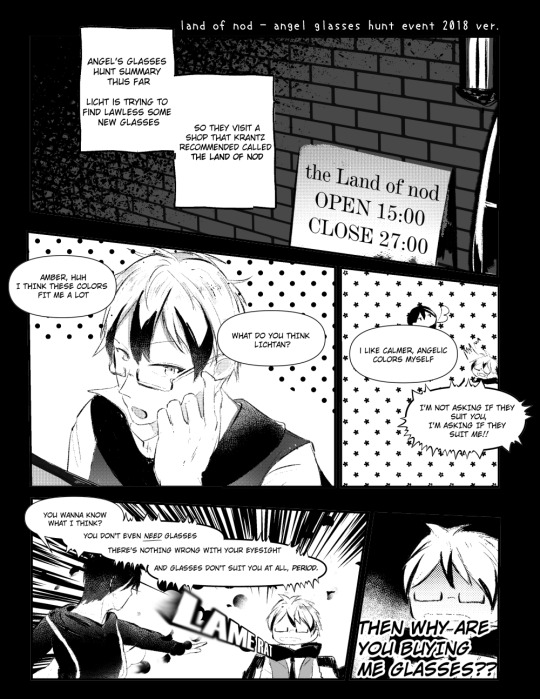

i just read last month’s chapter and it injured my feelings on top of getting the urge to draw
lawlicht block of text under the cut
So for context, this is a scene from Angel’s Glasses Hunt (2018 ver) Lawless’ birthday event for the game the Land of Nod (now called TANAKA BOX lmao).
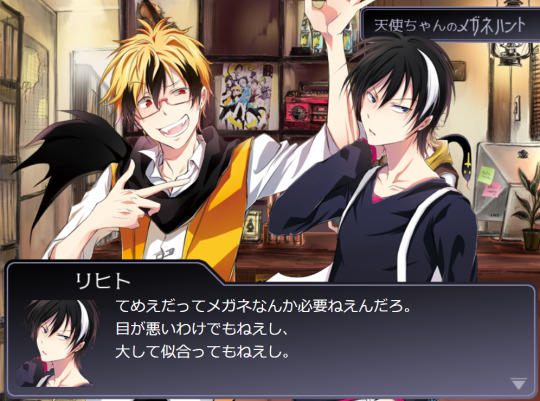
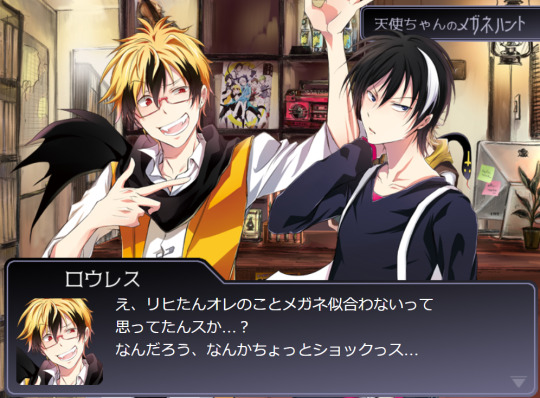
It was this point in the event that made me go “oh my god, that means Licht thinks Lawless looks better without glasses” and I forgot that became an hc of mine for a while.
No screenshots from this point on ‘cause I’m lazy, but in the ending of the event, Licht mentioned that on the day of their contract, “you took off your glasses that day didn’t you?” (damn I forgot which .5 chapter this is, but when Lawless introduced himself as Hydey the Hedgehog for the first time, he took off his glasses when introducing himself) and then Licht said something along the lines of “I thought you took off your glasses because you wanted me to let my guard down, but the truth is that’s not the case is it? You wanted to show me your true form, and you wanted to see with your own eyes.”
Listen, Licht says a bunch of confusing tenshi shit, but at least that’s how I interpreted his words. (Lawless doesn’t get the point either, or at least pretended he doesn’t get it). I wonder if this event’s been translated now, it’s been so long since it’s been rerun lol (I say 2018 ver. because after 2020? I think? It just became a glasses mini-game not a quiz answering game where you buy glasses and triggers small talks).
So yeah, on top of Licht thinking he doesn’t “like” Lawless wearing glasses, I think he sees a deeper meaning to it too, which to be fair isn’t completely wrong, he’d only gotten full fake and Shakepeare after he’d worn glasses.
bro what the fuck look at all this shit i just wrote
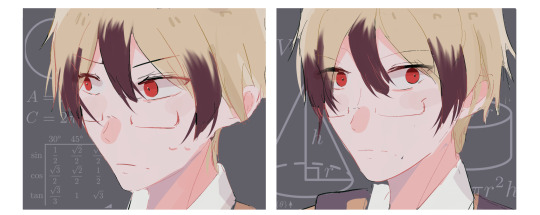
overthinking glasses-less lawless
So yeah I’m not gonna say anything about last month’s chapter, but the amount of... Not-wearing-glasses Lawless scenes in it re-ignited my forgotten “oh yeah doesn’t Licht fancy Lawless more without it?” personal headcanon from 4 years ago.
and one more thing. If anyone’s interested on playing the 2018 ver of Angel’s Glasses Hunt, it’s still accessible in the old domain (link here). If you want to play fair and actually have fun with the quiz, I wrote a general guide here. Again, don’t know if anyone’s translated it, but the full complete dialogue is archived here.
44 notes
·
View notes
Text


Sleepy Life of Servamp 17 That's how Gear provides for himself and Youtarou xD
Damn, he gives zero fucks! xD
In Tanaka Box they were apparently paranormal investigators, weren't they?
We don't know what Youtarou does, maybe he sells his knitted stuff online xD Also, omg I feel sorry for Gear, like has been run over by cars before? Poor wolf...Hopefully he never got hit by one the famous double decker buses!
Did you like my use of "woe is me?" I wanted to make him sound like a drama queen :)) I thought it fitted much better than the simple "Oh..." in the original text, you gotta know that he's a wolf living among humans and it's difficult!
Oh yeah, while I like this comic it came with something that was a little difficult to translate, so I need to explain.
You might have heard the words "boke" and "tsukkomi". These terms are from "manzai" the traditional style of stand-up comedy in Japanese culture, which usually involves two performers, a straight man (tsukkomi) and a funny man (boke).
In the Japanese text, Mahiru thinks ツッコミ不在 which means "absence of tsukkomi", thus, I could only conclude that he probably considered both Gear and Youtarou as boke xD Although, you probably think that Youtarou is the serious one because he did reprimand Gear about not using the "I'm a wolf" excuse, I thought: isn't that something that he might be saying a lot times to Gear?
Or it could be that neither Youtarou or Gear made wrong assumptions when Mahiru said: "Isn't it...bad?"
Gear seems to have understood that Mahiru was referring to the food being bad, while Youtarou commented that maybe going wouldn't be good because of how Gear looked.
So, that could be why Mahiru thought: "These two are airheads (boke)" xD
Maybe it's because I don't have much interest in manzai so these are the explanation I have for what Mahiru said, that being "absence of tsukkomi".
So yeah, I hope it helped a little, honestly, deciding how to adapt that word took some time, leaving it literal, but I figured that an explain is necessary, even though I don't quite grasp the concept that well.
#servamp#sleepy life of servamp#neugear hatiwelt#tsumugi youtarou#shirota mahiru#kuro#my translation
311 notes
·
View notes
Note
can i get uhhhh,,,, aone bf hcs?
my big baby ofc 😩

𝗮𝗼𝗻𝗲 𝗮𝘀 𝗮 𝗯𝗳 ҂ 𝘀𝗳𝘄
𝗮/𝗻 ҂ 𝗻𝗼𝗻𝗲

- ok so we all know he is a big and scary looking boy
- BUT OMG IS HE SOFT FOR U
- like he definitely uses his aura to scare weirdos away from u,,, he’s vv protective
- he loves it when you run ur fingers thru his buzzcut
- tall asf so he teases u by hiding things to where u can’t reach just so u have to ask him for help
- he’s so worried ab scaring u so whenever ur around he tries to make his face less... hard?? if that’s how u put it
- he stops scowling is what i mean lol
- DEEP ASS VOICE and u say it adds to his handsomeness and he MELTS
- he is a simp for u trust me
- he makes u a bento box but it’s got so much fucking food man,,, bc he don’t kno how to ratio for someone that isn’t his size
- like he gotta EAT and u don’t require that much
- moving on to cuddles!!
- i feel like he runs hot like tanaka so he is the blanket bae
- he loves how u curl up in his arms oh my GOD it’s so cute to him
- he’s still quiet with u but he makes more effort to speak
- bc of the above statement that u find his voice handsome
- basically he’s ur bodyguard that is also ur bf
- if ur a period having individual he’d totally go to the store and get supplies ( i _ i )
- he likes when u sit on his lap qwq
- his teammates tease both of u like “how did aone get someone to date him when he never speaks??”
- u stand up for him and joke ab fighting them hehe
- 100% cutest bestest boyfie ever u better let him coddle u bc he wants u to be his cute baby

© mik4sas 2021; do not steal or translate
#haikyuu scenarios#haikyuu imagines#haikyuu x reader#aone x reader#aone headcanons#haikyuu aone#aone soft hours
182 notes
·
View notes
Photo

I got an ask by @t-misaki where they wanted to know if there was a way to contact Tanaka Strike to ask a question. I do know that Tanaka has a PO box with ComicGene where you can submit fanletters and such. Since it’s unrealistic for us fans here in the ENG fandom to send letters to Japan, I didn’t answer. This twitter anniversary event seems more accessible. I suggest you ask or commission a translator for help with writing questions in Japanese.
However, please be respectful with questions. Don’t put fandom drama like ship wars into the tag. I was seriously questioning if I should post about this after I’ve seen how this fandom attacked my friend on twitter for a different opinion. Please don’t make me regret sharing this.
The additional question in the ask I got by was what Licht’s tattoo would be. Their tattoo are usually based off their Lead or their contract chain. Since Hyde and Licht’s contract chain is rather simple but in violet and gold, I would assume his tattoo is a piano keyboard on his ankle.
27 notes
·
View notes
Text

COSTUME GACHA ST@RT!
The special Costume Gacha has returned! This box will features the new 2024 Another Color Swimsuit limited outfits as well as past swimsuits along with the current permanent pool of cards.
※ you are only able to do PAID pulls with this special box ※ the contents of the box feature all PERMANENT cards adding on LIMITED cards released until 2024/02/28 15:00 JST
Every 10-pull will also give you one Outfit Pick Ticket, that will allow you to choose one of the outfits available. If you have obtained every outfit available, the ticket given will be a LTD-including SR Minimum Ticket
※ the contents of the box feature all PERMANENT cards adding on LIMITED cards released until 2024/02/28 15:00 JST
The costumes available for this gacha are:
[2020] Refresh Summer
[2021] Fountain Summer
[2022] Hottest Summer
[2023] Delight Summer
[2024] Another Color Swimsuit ※ flavor text translations located under the readmore
The box will run until September 21st 11:59 JST
2024 UNIT COSTUME FLAVOR TEXT TRANSLATIONS
illumination STARS
[Shiny Summer (aot)] Mano Sakuragi Change! Brand new COLORS
[Fashionable Summer (aot)] Hiori Kazano Change! Brand new COLORS
[Fashionable Summer (aot)] Meguru Hachimiya Change! Brand new COLORS
L’Antica
[Hottest Summer (aot)] Kogane Tsukioka Change! Brand new COLORS
[Delight Summer (aot)] Mamimi Tanaka Change! Brand new COLORS
[Hottest Summer (aot)] Sakuya Shirase Change! Brand new COLORS
[Remember Summer] Yuika Mitsumine Change! Brand new COLORS
[Fashionable Summer (aot)] Kiriko Yukoku Change! Brand new COLORS
HO-KA-GO CLIMAX GIRLS
[Remember Summer] Kaho Komiya Change! Brand new COLORS
[Refresh Summer (aot)] Chiyoko Sonoda Change! Brand new COLORS
[Refresh Summer (aot)] Juri Saijo Change! Brand new COLORS
[Remember Summer] Rinze Morino Change! Brand new COLORS
[Fountain Summer (aot)] Natsuha Arisugawa Change! Brand new COLORS
ALSTROEMERIA
[Shiny Summer (aot)] Amana Osaki Change! Brand new COLORS
[Fountain Summer (aot)] Tenka Osaki Change! Brand new COLORS
[Hottest Summer (aot)] Chiyuki Kuwayama Change! Brand new COLORS
Straylight
[Refresh Summer (aot)] Asahi Serizawa Change! Brand new COLORS
[Remember Summer] Fuyuko Mayuzumi Change! Brand new COLORSy
[Remember Summer] Mei Izumi Change! Brand new COLORS
noctchill
[Refresh Summer (aot)] Toru Asakura Change! Brand new COLORS
[Remember Summer] Madoka Higuchi Change! Brand new COLORS
[Refresh Summer (aot)] Koito Fukumaru Change! Brand new COLORS
[Remember Summer] Hinana Ichikawa Change! Brand new COLORS
SHHis
[Remember Summer] Nichika Nanakusa Change! Brand new COLORS
[Hottest Summer (aot)] Mikoto Aketa Change! Brand new COLORS
CoMETIK
[Delight Summer (aot)] Luca Ikaruga Change! Brand new COLORS
3 notes
·
View notes
Note
meme or serious answer, either works
i've been away for awhile, how's the servamp fandom going ?
anything big and important ?
most importantly how are you ?
I'm doing well, thank you for asking!! Glad to see you back, anon :D How about you??
Well... We had our 10th anniversary! Which is super exciting and a huge milestone. We also got our hundredth chapter! We know what country Kuro's from! We got to see him as a human! We're getting to see how all the Servamps met! Two new Drama CDs released recently, there's a second art book now, we got a Stage Play, Halloween reran with extra goodies, Mikuni's birthday event has a newly added Misono route...
Lots and lots of things happened! We have plushies!!!

(Photo sourced from Tanaka-sensei's twitter)
There's also a couple new Servamp Servers on Discord, Pandora's Box, an 18+ server (as in your have to be 18 to join, not that it's focused on 18+ content) and a general server called Servamp Community that was adopted off of Reddit. I'm part of both so come check them out if you feel like it! Neither move too fast and everyone's super nice ^^
Oh, and! Hello-vampire-kitty has started streaming the new chapter RAWs live now! We call ourselves the masochist's book club ww. It's really fun!
There's also the blog servamp-announcements, which has been posting translations of official news and such about the series, from character birthdays to merch to chapter news to updates from Strike. I really appreciate the work they do to keep us all updated ;w;
Most importantly...
My baby boy got to have LOTS of screentime with his crush in the anniversary drama cd. I owe Strike my life for giving me everything I could have wanted with those two fkghfdk
8 notes
·
View notes